GETTING THERE AND MAKING A DIFFERENCE





1technation.com Vol. 15 ADVANCING THE BIOMEDICAL / HTM PROFESSIONAL
P.23 | SARAH STEM HTM Community Mourns Passing of Friend P.44 | ROUNDTABLE Endoscopes P.77 | SCRAPBOOK Florida Biomedical Society
LESSONS LEARNED IN LEADERSHIP
PAGE 50


















www.pronktech.com 800.609.9802 printsales@pronktech.com • • MADE IN USA NEW




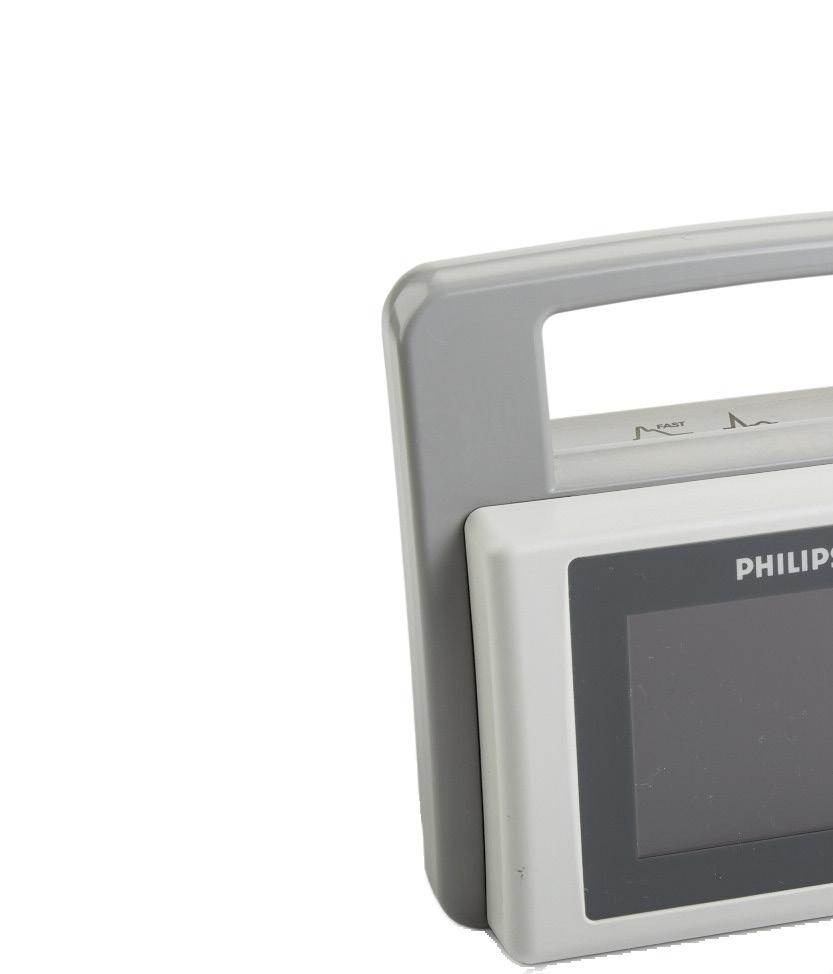


NEW YEAR’S SALE CONTACT US TODAY FOR ALL YOUR DEVICE NEEDS! CALL: 1.855.888.8762 VISIT: USOCMEDICAL.COM SIMPLE SOLUTIONS FOR COMPLEX DEVICES REPAIRS & RENTALS ON-SITE BLENDER OVERHAULS TRAINING CLASSES 2 LOCATIONS TO SERVICE YOUR REPAIR NEEDS






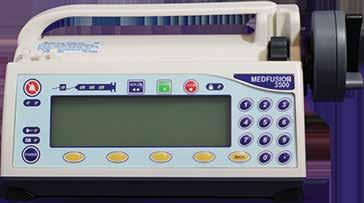







The manufacturers listed are the holders of their respective names and/or trademarks, and are not to be taken as an endorsement or a liation with AIV, Inc. Infusion Pump Support & Power Solutions 776C Infusion Pump Support AIV-Manufactured Replacement Parts Power Cords & AC Adapters Fixed or Flat Rate Repair Options on Many Popular Pumps PowerMATE Family AIV’s Special Purpose Relocatable Power Taps Check out the PowerMATE -CM with current monitoring! Visit our Website!



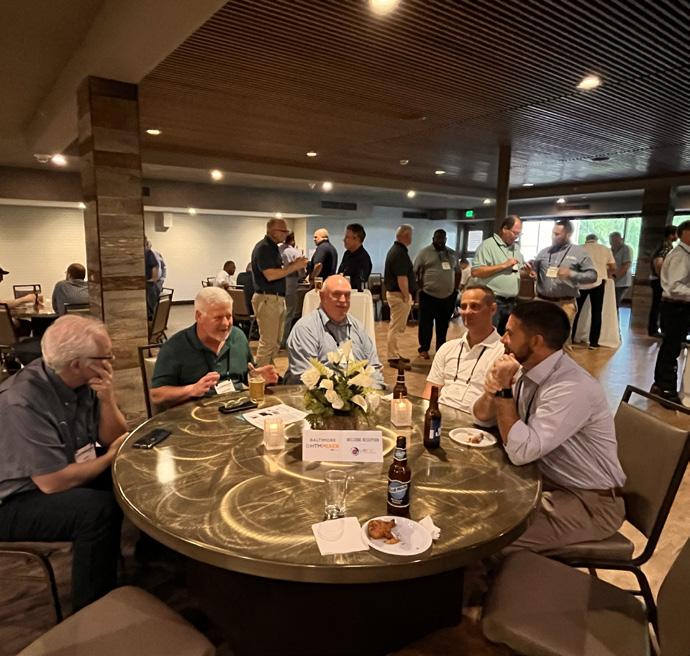
DATE

MAY 2-3, 2024
PROUDLY SPONSORED BY:
I B S
THIS EVENT IS IN LIEU OF THE IBS 2024 CONFERENCE.
SAVE THE
INDY THE WESTIN • INDIANAPOLIS, IN


You can’t risk getting subpar quality. Who’s in your corner? Monitors | Modules | Telemetry


Supply chain issues and low-quality parts from offshore vendors can wreak havoc on your timeline and bottom line. You need a support team who understands the pressures you face and provides solutions — from new and T.Certified pre-owned products to top-quality repair parts — that fit your budget.
We’re in YOUR corner. Call today to schedule repairs, purchase parts or lease equipment.
800.297.2241 | Tenacore.com
Infusion Pumps | Defibrillators | ESU LEASE OR BUY!
Katy Director of Operations

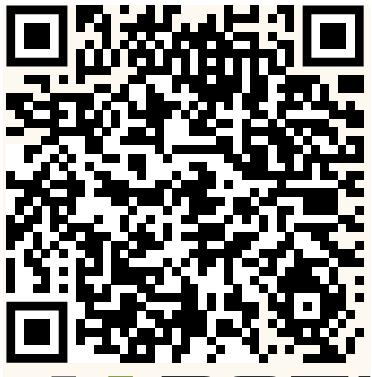



CHECK OUT OUR COURSE CALENDAR! rsti-training.com | registration@rsti-training.com Register online at rsti-training.com/register or call 440-349-4700 Improving the quality of diagnostic imaging service through knowledge, education and Fully Engaged Hands-on Learning™. ISO 9001:2015 Certified (IQC Certificate No. Q-1158); State of Ohio Reg. No. 93-09-1377T

Centers of Excellence for Ultrasound Probe and MRI Coil Repair, and Design & Manufacturing Innovatus Imaging vs. XYZ Probe Repair Which is best for you, your patients, and your budget? Take the Probe Repair Challenge and find out! 844-687-5100 customercare@innovatusimaging.com Scan here to see how our clients are optimizing their uptime and budget with Innovatus Imaging. Visit us at booth 203 at MDExpo in Las Vegas April 7 - 9
CONTENTS
P.12 SPOTLIGHT
p.12 Department of the Month: Cook Children’s Medical Center HTM Department
p.14 Professional of the Month: Victor Rojo
p.18 Association of the Month: The Georgia Biomedical Instrumentation Society (GBIS)
p.20 Next Gen: Keilah Mae Perez
p.23 HTM Community Mourns Passing of Friend: Sarah Stem
P.25 INDUSTRY UPDATES
p.25 News & Notes
p.32 AAMI Update
p.34 Ribbon Cutting: Vital Capital
p.36 ECRI Update


44
P.39 THE BENCH
p.39 Tools of the Trade
p.40 Biomed 101
p.42 Webinar Wednesday
P.44 FEATURE ARTICLES
p.44 Roundtable: Endoscopes
p.50 Cover Story: Lessons Learned in Leadership: Getting There and Making a Difference
P.54 EXPERT ADVICE
p.54 Career Center
p.57 SPONSORED: Avante Health Solutions
p.58 Networking Notes
p.60 SPONSORED: Innovatus Imaging
p.62 The Future
p.64 SPONSORED: Crothall Healthcare
p.66 Cybersecurity
p.68 Health-ISAC
TechNation (Vol. 15, Issue #4) April 2024 is published monthly by MD Publishing, 1015 Tyrone Rd., Ste. 120, Tyrone, GA 30290. TechNation magazine is dedicated to providing medical equipment service professionals with comprehensive, reliable, information concerning medical equipment, parts, service and supplies. It is published monthly by MD Publishing, Inc. Subscriptions are available free of charge to qualified individuals within the United States. Publisher reserves the right to determine qualification for a free subscriptions. Every precaution is taken to ensure accuracy of content; however, the information, opinions, and statements expressed in the articles and advertisements herein are those of the writer and/or advertiser, and not necessarily those of the publisher. ©2024
23
April 2024 | TechNation 9
PUBLISHER
VICE PRESIDENT
John M. Krieg
Kristin Leavoy
VICE PRESIDENT Jayme McKelvey OF SALES
EDITORIAL
CONTRIBUTORS
ACCOUNT
EXECUTIVES
ART DEPARTMENT
DIGITAL SERVICES
EVENTS
WEBINARS
HTMJOBS.COM
ACCOUNTING
John Wallace
Roger Bowles
K. Richard Douglas
Jim Fedele
Joie Marhefka
Manny Roman
Steven J. Yelton
Megan Cabot
Emily Hise
Karlee Gower
Taylor Hayes
Kameryn Johnson
Cindy Galindo
Kennedy Krieg
Haley Wells
Kristin Leavoy
Linda Hasluem
Kristen Register
Sydney Krieg
Diane Costea
CIRCULATION Joanna Manjarrez
EDITORIAL BOARD
Rob Bundick, Director HTM & Biomedical Engineering, ProHealth Care
Carol Davis-Smith, CCE, FACCE, AAMIF, Owner/ President of Carol Davis-Smith & Associates, LLC
Jim Fedele, CBET, Senior Director of Clinical Engineering, UPMC
Bryant Hawkins Sr., Site Manager, Children’s Hospital of New Orleans
Benjamin Scoggin, MBA, MMCi, Director, Clinical Engineering | Biomedical Operations, Equipment Distribution, Clinical IT, DHTS, Duke Health Technology Solutions
Allison Woollford, Biomedical Equipment Specialist at Duke University Health System
DIGITAL ADVISORY BOARD
Bryant Hawkins Sr., HTM on the Line, Trimedx Site Manager at Children’s of New Orleans
Dr. Brian Bell, HTM Workshop, Faculty Biomedical Engineering at St. Petersburg College in St. Petersburg, Florida
Carlos Villafane, BMET Latino, Certified Biomedical Engineering Technician III, Baycare Health Systems
Chace Torres, Bearded Biomed, Lead Technician SPBS, Dallas-Fort Worth Metroplex


MD Publishing / TechNation Magazine 1015 Tyrone Rd., Ste. 120, Tyrone, GA 30290 800.906.3373 • Fax: 770.632.9090 Email: info@mdpublishing.com www.mdpublishing.com Proud supporters of P.72 BREAKROOM p.72 CONTEST: What’s on Your Bench? p.73 TechNation Poll p.74 MedWrench Bulletin Board p.75 Biomed Brainbuster p.77 FBS Scrapbook p.82 #ShowUsYourShop p.78 Service Index p.81 Alphabetical Index 77 Like us on Facebook, facebook.com/TechNationMag Follow us on LinkedIn, linkedin.com/company/iamtechnation Subscribe to TechNation TV, youtube.com/@TechNation_TV
10 TechNation | April 2024
To
New Terms every 6-Weeks
CBET’s online education and training programs are designed with quality and flexibility in mind, tailored specifically to the needs of working adults.
We offer 100% online programs that include immersive VR lab experiences for biomedical equipment technician training.








210.233.1102 www.cbet.edu
Take the next step in your HTM Professional Journey
speak with
Academic or
Counselor call us at 210.233.1102 or visit www.cbet.edu/apply-now. HISM & BMET DoD Approved Veterans Training VR Labs Fully Integrated Certificate & Degree Programs
an
Career
DEPARTMENT OF THE MONTH
Cook Children’s Medical Center HTM Department
BY K. RICHARD DOUGLAS
Pediatric hospitals in large urban areas often have a very large potential patient population, inclusive of the city and surrounding suburbs.
The North Central Texas city of Fort Worth is a prime example of a major city with a number of bedroom communities surrounding it. The former pre-Civil War army outpost has gone from hosting cowboys and cattle drives to museums and nightlife.
Serving the pediatric population of this vibrant city and its growing metro area is Cook Children’s Health Care System.
“We have two hospitals; 425-beds and a 105-beds, six urgent care centers and over 35 clinics in our Dodson multi-specialty building and throughout the community,” says Leo Velasquez, operations manager of clinical engineering and central equipment.
The large HTM department, which is comprised of two groups, also includes Director Sal Cruz. Like Velasquez, Cruz oversees the combined department that includes clinical engineering and central equipment.
In addition to Cruz and Velasquez, Rebecca Vega is contract and asset manager. Catina Hendrix is the group’s work control technician/dispatcher.
“Clinical engineering takes care of all medical equipment, all nurse calls, all beds, stretchers and cribs, all patient TVs and all patient room gaming systems,” Velasquez says.
He says that clinical engineering consists of four specialized team areas: the general biomed team consists of one BMET 3, three BMET 2s (one takes care of laboratory, one takes care of respiratory and one is the networking/monitoring specialist) and four BMET 1s.
The department’s imaging team has an imaging tech 3 and an imaging tech 2. The department’s surgery team resides in the surgical suites and consists of one senior surgery BMET, one surgery BMET 2 and a surgery BMET 1.
“We also have four full-time contractors that take care of central equipment assets (IV pumps, bili lights, SCD units and standalone monitors, and – since COVID started – about 200 powered air purifying respirators [PAPR] units) and one part-time contractor to service and administer our RTLS system,” Velasquez says.
He says that central equipment is the department that makes sure that all clinical areas have enough equipment to care for patients. They run three shifts 24/7.
The group also has one lead equipment distribution tech and 12 equipment distribution techs (four per shift). Their duties include cleaning and disinfecting movable medical equipment, assuring that PAR levels are maintained in clinical areas; acting as runners for special equipment pickup and delivery between departments and the sterile processing department. They also order special needs rental equipment for patients.
The central equipment team assists with finding medical equipment that is due for PMs.
CONTRIBUTING TO A GROUNDBREAKING SURGERY
The two teams that comprise HTM have tackled a number of projects in recent years, including assistance in a complex operation and challenges presented by the COVID-19 pandemic.
“Over the last several years, our clinical engineering/HTM department has been involved in large organization-wide projects that really showcased our value to the hospital,” Velasquez says.
He says that for 2020 and 2021, the hospital was deeply
SPOTLIGHT
12 TechNation | April 2024



affected by the national shortage of PAPR products.
“We were unable to get more of the air hoods for the 3M PAPR units we had since all respirators were on,” Velasquez says.
He says that the biomed team designed and built an ultraviolet C (UV-C) room with racks and shelves that was modeled after one built by the University of Nebraska. It was capable of disinfecting PAPR hood and N-95 mask from viral and bacterial contamination.
This operation was 24/7 for one and a half years.
A new hospital, wing or OR is always a big project for HTM. In 2022, the team at Cook Children’s assisted in the preparation to open a new hospital in Prosper, Texas, 50 miles north of the main Fort Worth hospital.
“Our department, and especially our director Sal Cruz, were instrumental in many aspects of selecting, sourcing and installing the equipment into the hospital, even with severe supply chain issues, we were able to make sure that the hospital was able to open on time,” Velasquez says.
In 2023, Cook Children’s was the first hospital in North Texas to separate conjoined twins. The HTM team was instrumental in converting the single OR suite used into a double room that two surgical teams used to care for the separated twins, according to Velasquez.
two independent EPIC work stations functioning, all of this was needed to fit in an acceptable footprint to allow the required staff enough space to attend to each patient. Power, light, medical gasses and IT integration were issues that the HTM team addressed.
“The first anesthesia machine was easy because it, and the accompanying EPIC, was already established in the suite. In order to install the second anesthesia machine, we had to experiment with many different gas connectors, air connectors and hose configurations in order to find the right combination in order to fit all the needs of the staff,” Burton says.
“Over the last several years, our clinical engineering/HTM department has been involved in large organization-wide projects that really showcased our value to the hospital.”
- Leo Velasquez
Senior Surgery Biomedical Equipment Technician Jay Burton, CBET, became a part of the setup team.
“Earlier this year, Dr. Yamout approached the lead wanting assistance in setting up a second anesthesia machine in the OR in order to accommodate newly separated twins. Our OR suites are not designed to have two patients and all the devices needed to support them, so we had to come up with a plan,” he says.
Burton explains that the goal was to get two anesthesia machines working independently of each other, as well as getting
EPIC was also needed on the second anesthesia machine. Because with only one EPIC assigned per room, they had to “borrow” a room number and add it the suite the procedure was being performed in. In order to accomplish this, they had to go to the IT closet and jump the communication cable to a communications port in proximity to the second anesthesia machine.
“After some testing and a couple of ‘dry runs,’ it was decided by all that our plan was sound and going to work. The conjoined twins were successfully separated,” Burton adds. “We did also open up a new medical office building to house our hospital associated clinics. Currently, we are now working on a project to make our central sterile processing Department compliant with new standards of critical water for sterilization (AAMI Standard ST108),” Velasquez says.
Team members have pursued certification and are involved in the local HTM community.
“We have six team members that are AAMI certified. We do have several techs that attend the local HTMA-NTX meetings/meet and greets,” Velasquez says.
The diverse skill sets of the HTM professionals with Cook Children’s keeps children in north Texas healthy.
Salvador Cruz is the director of clinical engineering. BMETs Quac Le, Jay Burton and Frank Pecorino return a device to the hospital floor.
April 2024 | TechNation 13
Cook Children’s BMETs include surgical specialists Ryan Davis, Jay Burton, and Dustin Haberstroh.
PROFESSIONAL OF THE MONTH Imaging Specialist to Leadership
Victor Rojo
BY K. RICHARD DOUGLAS
The largest provider of pediatric care in the Chicagoland area is the Ann & Robert H. Lurie Children’s Hospital of Chicago. With 21 operating rooms, the hospital is committed to research initiatives to advance the prevention, diagnosis and treatment of diseases that impact children’s health.
To ascertain the mission of the hospital is carried out, the management of medical devices is a key component. The hospital’s HTM team oversees this responsibility. Victor Rojo manages this team of professionals.
Rojo works for Crothall Healthcare as resident regional manager at the hospital. Rojo knew from early on that he wanted a career in electronics but did not have an exact career path picked out at first.
“In my early 20s, while working as a patient transporter at Children’s Memorial Hospital, I was also completing my bachelor’s degree in electronics engineering. Feeling unsure about my future, I noticed a gentleman working on infusion pumps, sparking my interest in the field. After befriending him and discovering we shared the same degree, I promptly secured an internship through the director’s office. This marked the beginning of my rewarding career in the HTM/ biomed profession,” he says.
Rojo’s area of specialty, during his years as a technician, was imaging.
“After earning my bachelor’s degree in electronic engineering, I began my career with on-the-job training for biomedical tasks, specializing in safety checks for infusion pumps. Over the course of a few years, my employer recognized my potential and sponsored my attendance at
imaging school where I became an imaging specialist, working on diverse equipment like X-ray, MRI and CT scanners. As my educational pursuits progressed, I seamlessly transitioned into a managerial role. The culmination of these experiences solidified my commitment to excellence, underscored by the pursuit of an MBA to further enhance my expertise,” Rojo says.
He says that he began his career as a biomed intern, advancing to the role of a progressive biomed, and later became an imaging specialist.
“Following that, I assumed responsibilities as an assistant director before reaching my current position as the director at Lurie Children’s Hospital in Chicago, Illinois,” Rojo says.
PUTTING CYBER THREATS INTO AN ARM BAR
The cybersecurity landscape within health care has required an emphasis on this critical focus within HTM and IT. The cyber threat has become so pervasive within health care that it has required special projects and specialists within HTM to address it.
“Recognizing the evolving landscape of cyber threats, our hospital proactively responded by establishing a specialized task force aimed at containing protected health information (PHI) and mitigating cybersecurity threats. As a strategic evolution, we made the deliberate decision to restructure our department, creating two distinct divisions. One division focuses on seamless operations and service delivery, while the other is exclusively dedicated to the realms of cybersecurity, project management and capital planning,” Rojo says.
He says that this strategic separation has proven to be instrumental, and his team takes great pride in the comprehensive oversight provided by the cybersecurity division across all devices within the hospital.
“Their multifaceted responsibilities encompass meticulous project planning and the vigilant monitoring of cybersecurity threats, with a specific emphasis on those
SPOTLIGHT
14 TechNation | April 2024
related to medical devices,” Rojo adds.
When not on the job, Rojo enjoys his family and martial arts activities.
“I’m part of a close-knit family rooted in Chicago. My parents and siblings also call this city home. In my immediate family, there’s my wonderful wife, a delightful 10-year-old daughter, and a slightly fussy, but lovable dog that adds an extra layer of joy to our lives,” he says.
Rojo has practiced the very scientific martial art of Brazilian Jiu-Jitsu for four years.
“It’s more than just a hobby; it’s been a transformative force in my life, serving as a stress reliever and a source of joy. Engaging in Brazilian Jiu-Jitsu sessions with friends is not just physically invigorating but also mentally uplifting. If anyone shares a passion for Brazilian Jiu-Jitsu, I’m always eager to engage in conversations about it. Feel free to reach out if you’re interested in discussing the world of Brazilian Jiu-Jitsu,” he says.
His enthusiasm for his profession and the environment he works in are genuine. He is also grateful for the support of his employer.
“In my own words, there hasn’t been a single day at Lurie Children’s Hospital where I didn’t wake up fueled to head to work. Even on those groggy mornings, my love for what I do keeps me going strong. Over my extensive 20-year career, boring moments are pretty much nonexistent. Since jumping on board at Lurie Children’s Hospital, the thought of waking up and not wanting to tackle the day is alien to me,” Rojo says.
With that attitude, this HTM leader is an asset to all who come in contact with him. For those on the mat though, it may mean a submission.




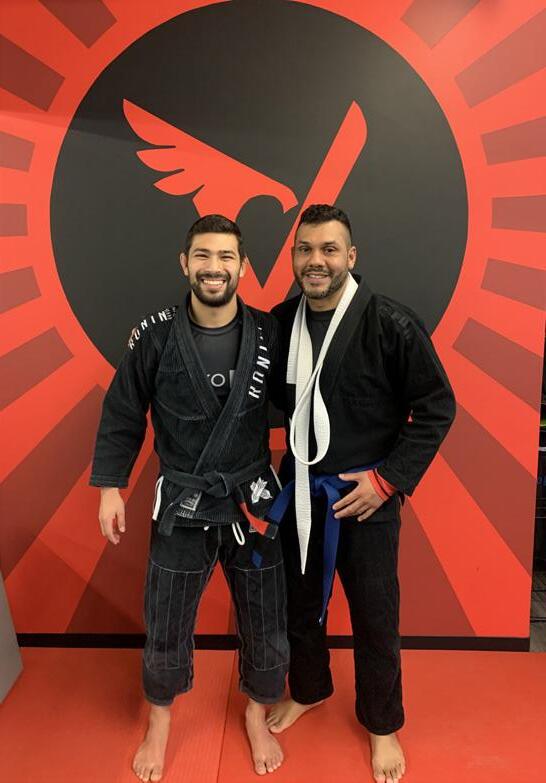
BIOMETRICS
FAVORITE BOOK: Malcom Gladwell’s “Outliers”
FAVORITE MOVIE:
“BMX Bandits” (an old movie from the 1980s LOL)
HIDDEN TALENT:
I’m pretty good at doing tricks with yo-yos.
FAVORITE FOOD:
A good rib eye steak
FAVORITE PART OF BEING A BIOMED?
Collaboration with clinicians. I love finding solutions when a clinician can’t find the right answer or having trouble with their equipment.
WHAT’S ON MY BENCH?
My standing desk, speaker, white board, coffee and work planner.
April 2024 | TechNation 15
Victor Rojo’s has an energetic approach to work, family and Brazilian Jiu-Jitsu.

Top 10 Health Technology Hazards for 2024 Prevent dangerous device hazards and improve patient safety SPECIAL REPORT Download Now www. ecri.org/2024hazards
Verify the Integrity of Equipment
The Insulation tester, Leak Tester Tester, Shaver Leak Tester and Cable Continuity Tester are easy-to-use devices for verifying the functionality of equipment for safety
McGan Insulation Tester
Detect & locate defects such as pinholes, cracks and bare spots in the jacket or coating of laparoscopic and bi-polar electrosurgical instruments

Cable Continuity Tester
Leak Tester Tester
Test the functionality of automated & handheld endoscope leakage testers with healthmark’s new Leak Tester Tester.

Test the quality of monopolar and bipolar cords with this user-friendly, durable device. A green light noti es the user that the cable passed testing.

Shaver Leak Tester

Designed for pressure testing arthroscopic shavers to help identify leaks caused by failing seals that degrade over time from repeated use and processing.
For more of Healthmark’s intelligent solutions for instrument care & infection control, visit hmark.com
hmark.com |
| healthmark@hmark.com
800.521.6224
ASSOCIATION OF THE MONTH
The Georgia Biomedical Instrumentation Society (GBIS)
BY K. RICHARD DOUGLAS
When Ray Charles covered the Hoagy Carmichael song “Georgia on My Mind,” he was singing about the state where he grew up. The song has been the official state song for the Peach State since the late 1970s. With mountains in the north, a coastline on the Atlantic Ocean and bordering South Carolina, Tennessee, Alabama and Florida, the state of Georgia is unique and worthy of inspiring a ballad.
The state’s HTM association, the Georgia Biomedical Instrumentation Society (GBIS), has been a staple for the biomed community for 39 years. The group’s executive director is Horace Hunter.
“GBIS was formed from the four local biomedical societies after seeing participation depleting – Atlanta Area Biomedical Association led by Emmanuel King and Dr. Mike O’Rear, Central Georgia Biomedical Society lead by Dean Fripps, Savannah Biomedical Society led by Bob Carey and South Georgia Biomedical Society, led by Horace Hunter,” Hunter says.
He says that the remaining board members and other members from each group were part of the decision to unite and form a state group. GBIS was formed in 1985
and was officially incorporated in 1998.
“Dr. Mike O’Rear, a co-founder, board of trustee and lifetime member of GBIS passed away December 2022. Dr. O’Rear, also called Mike, was the first biomed instructor teaching in the state of Georgia. He was at Chattahoochee Technical College for more than 30 years. Christa Shiver, Dianne O’Rear, Emmanuel King and Horace Hunter rotated as various officers on the board of directors until everyone felt it was time to promote them to board of trustees so others can participate as officers,” Hunter says.
He says that GBIS was founded on the mission to promote the HTM profession by advancing the knowledge of personnel involved in the selection, development, operation, repair and support of biomedical technology.
“In the beginning, GBIS conducted technical conferences across the state of Georgia during a period of time when many hospitals would not send technicians to manufacturer service schools. GBIS members also wanted to support and contribute to charity organizations like – AAMI Foundation, Behm Birth Defects, Med Share and others,” Hunter says.
GBIS also developed media partnerships with TechNation, MD Expo, DotMed, AAMI and other publishing organizations to help members gather information in the field of biomedical technology,” Hunter adds.
REMEMBERING AN IMPORTANT CONTRIBUTOR
The pandemic threw a wrench in even the best intentions of
SPOTLIGHT
18 TechNation | April 2024


many biomed associations. In-person meetings became challenging or non-existent and many routine functions had to be cancelled. The Georgia group was forced to take a break from the annual event that was normally a part of its schedule.
“GBIS did not host a conference from 2020 to 2022 due to the COVID-19 pandemic and safety of our members. In 2023, GBIS conducted our annual conference at the new Children’s Healthcare Medical Center in Atlanta. We had some eight technical classes certified by AAMI and more than 100 participants. Michael Cameron, conference chairperson, and his committee did an excellent job coordinating the conference and selecting various food and refreshments,” Hunter says.
He adds that the highlights for last year’s conference were a surprise event to honor Dr. Mike O’Rear by giving a plaque to his family. Also, the conference was coordinated by a new group of GBIS members; giving other members a chance to lead the group, Hunter says.

During HTM week, GBIS invited members to participate in a picture-take and proclamation signing with the governor of Georgia. As members come up with ideas to promote a healthcare technology management career, GBIS will continue to [offer] support,” Hunter says.
The state’s HTM association, the Georgia Biomedical Instrumentation Society (GBIS), has been a staple for the biomed community for 39 years.
GBIS holds an annual meeting after the conference and all meetings are held online using Go To Meeting or Zoom.
Hunter says that the society has conducted workshops in the past with support from corporate members.
“GBIS supports and encourages members to go to the schools and share an HTM career. Last year, Nikhil Shirke and Bill Bruce conducted a career day event at a school in Atlanta.
GBIS has a scholarship program for biomeds who complete the AAMI certification. Additionally, the organization supports several technical schools and community colleges including Mira Costa College, Georgia Gwinnett College, College of Biomedical Equipment Technology and any school or college that needs its support.
One role that biomed associations play in the larger HTM community is finding replacements for the many veteran biomeds who are retiring from the profession.
“GBIS is in the process of developing a new board of directors that will set a goal on how to find and recruit new members,” Hunter says.
Combined with its work with college biomed programs, GBIS is doing its part to help channel new biomeds into the profession in Georgia.
Ready for new leadership, one of the country’s oldest biomed organizations continues to provide benefits to the state’s HTM community.
GBIS welcomed more than 100 participants to its 2023 annual conference.
April 2024 | TechNation 19
One of the plaques given to the O’Rear family in honor of Dr. O’Rear.
NEXT GEN POWERED BY YP AT MD
Keilah Mae Perez
Keilah Mae Perez is “awesome” according to coworker David Scott at UC Health in Colorado. TechNation found out more about this bright member of the Next Gen including her goal to become CBET certified.
Q: WHERE DID YOU GROW UP?
A: Donna, Texas
Q: WHERE DID YOU RECEIVE YOUR HTM TRAINING/ EDUCATION?
A: I studied at Texas State Technical College and did a semester internship at South Texas Health System Children’s Hospital.
Q: HOW DID YOU FIRST DISCOVER HTM?
A: Funny story, I was at a high school college fair and took a tour of the college I attended. I was introduced by my professor, who at the time was just our tour guide, and she gave us a run down on what the biomed program was and it just sparked my interest. Once I graduated high school, I immediately signed up for the program.
Q: HOW DID YOU CHOOSE TO GET INTO THIS FIELD?
A: I truly chose to become a biomed because I like tearing a piece of equipment apart, finding the problem and making it work again. I had never even heard about biomed until I went to that college fair. I had a girl professor named Star that had said there were not a lot of girls in the field because it was more male dominant, that truly gave me a bit of motivation to show what a girl can do in a “male dominant field.”
Q: WHAT DO YOU LIKE MOST ABOUT YOUR POSITION?
A: I love that I am helping patients indirectly. I’m not a nurse and in contact with patients 24/7, but I am helping in the back end where if something doesn’t work with the equipment I am the one with a solution. I also love that in this position I am always learning something because medicine is always

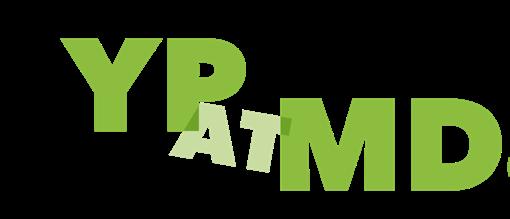
evolving and that means technology/equipment is too –meaning more opportunity to learn.
Q: WHAT INTERESTS YOU THE MOST ABOUT HTM?
A: What is so intriguing to me is that there is always something to learn on a daily bais. It’s the troubleshooting that gets me excited because once you find the problem you know how to fix that piece of equipment. The reward is knowing with certainty that the machine you just fixed is going to a patient who is in real need of it.
Q: WHAT HAS BEEN YOUR GREATEST ACCOMPLISHMENT IN YOUR FIELD THUS FAR?
A: My greatest accomplishment is being employee of the year for the clinical engineering department.
Q: WHAT GOALS DO YOU HAVE FOR YOURSELF IN THE NEXT 5 YEARS?
A: To become CBET certified, and to become a level 2 tech. I also want to expand my knowledge in school where I want to become a biomedical engineer. I hope that maybe one day I’ll create a new piece of medical equipment.
FUN FACTS
FAVORITE HOBBY: Painting
FAVORITE SHOW OR MOVIE: “Grey’s Anatomy”
FAVORITE MEAL: Pho
WHAT WOULD YOUR SUPERPOWER BE?
Teleportation
1 THING ON YOUR BUCKET LIST: To travel to New Zealand
SOMETHING YOUR CO-WORKERS DON’T KNOW ABOUT YOU: I can play “Fur Elise” by Beethoven on the piano
SPOTLIGHT
20 TechNation | April 2024
PROBO MEDICAL
PROBO MEDICAL
Your Ultrasound Partner
Your Ultrasound Partner


FREE TECH SUPPORT
FREE TECH SUPPORT
QUALITY, TESTED PARTS
QUALITY, TESTED PARTS
ULTRASOUND SERVICE TRAINING
ULTRASOUND SERVICE TRAINING
PROBE REPAIR WITH FREE LOANERS
PROBE REPAIR WITH FREE LOANERS
NEXT DAY RENTALS
NEXT DAY RENTALS
SERVICE ACROSS THE US
SERVICE ACROSS THE US
Mention this ad for 10% OFF your next part or repair.
Mention this ad for 10% OFF your next part or repair.


HAVING PROBLEMS WITH YOUR ULTRASOUND PROBE?
HAVING PROBLEMS WITH YOUR ULTRASOUND PROBE?
Scan the QR code and get an instant quote by using our free ultrasound probe evaluation tool.
Scan the QR code and get an instant quote by using our free ultrasound probe evaluation tool.
WWW.PROBOMEDICAL.COM
WWW.PROBOMEDICAL.COM



22 TechNation | April 2024





2S marketing and sales professional Sarah Lynne Stem, 44, passed away February 13, 2024, following a bout with breast cancer. She was a beloved member of the J2S family, her local community in Ohio and the HTM community.
J2S employees came together to share the news of Sarah’s passing via Facebook.
“We are deeply saddened to share that last week we lost a beloved member of the J2S family, Sarah Stem, after a long battle with breast cancer,” the Facebook post reads. “Sarah’s joyful energy left an impact on everyone she encountered, both personally and professionally. She was a passionate advocate for the HTM industry and an integrity-driven team leader. Sarah was more than a colleague though; she had a way of making her employees and customers truly feel like family. We are committed to upholding Sarah’s bright vision for our company and honoring her legacy through the values she has instilled in J2S from our very first day in business.”
“We cannot thank our industry friends enough for your kindness and outreach during this tough time and throughout Sarah’s entire battle. The impact she has left on our team will be felt forever,” the post adds.
Tom Bledsoe, the owner of Bledsoe Imaging Group and president of the Kentucky Association of Medical Instrumentation (KAMI) considered Sarah a friend and a colleague.
“I first met Sarah through our local biomedical (HTM) society, known as the Kentucky Association for Medical Instrumentation (KAMI). Local is a loose term because we are in Kentucky, she was in Ohio. The first thing I noticed about her is her energy and her smile,” Bledsoe said. “She quickly became involved, and was elected to the board of directors, typical of Sarah, and was instrumental in planning our very first annual symposium. If you’ve never been in the planning of one of these it can be daunting. Without this conference, I genuinely think our organization could have folded. She rolled up her sleeves and jumped into action, including creating swag bags, banners, name tags, and probably things I never knew of. We were like-minded and said if we were going to go down, we were going out with style. The KAMI BOD has often heard me say, ‘If it weren’t for Sarah, this event would not have been the success it was.’ Obviously, it took the whole team to plan and pull off a symposium like ours, but I loved the way she and her team took over tasks of which I wasn’t even aware. She will be missed in the industry and KAMI.”
“I will miss my dear friend and that smile!” he added.
Her signature smile always added a positive jolt to those who encountered it and it was an infectious grin that always seemed to be on display whether she was in the office, meeting a customer, attending a conference or making a trip to the grocery store.
Several colleagues have shared their memories and thoughts about Sarah since her passing. The following is just a small sample of what she meant to so many people in the HTM community.
HTM COMMUNITY MOURNS PASSING OF FRIEND J
“Sarah was always bright and shiny. She had a big smile and a wicked sense of humor. Sarah and J2S have been excellent partners since I met them in 2015. I will miss you until we all meet on the other side. And somebody keep the cactus watered,” said John Schafer, biomed manager with Renovo.
“Sarah and I met over a decade ago when we both started our own companies. Although we were in completely different sides of the HTM industry, we still worked together on ideas of managing conferences and employees. Her positive and outgoing personality made it a true pleasure to work alongside her. She will truly be missed and the HTM industry lost an amazing person. My thoughts and prayers are with her family and the J2S team,” shared Alex Maldonado, owner of Exclusive Medical Solutions.
“I am deeply saddened to hear about Sarah’s passing. I’ve mostly had the pleasure of collaborating with her at conferences. Sarah was always very kind and professional. She was also very knowledgeable and could always help find us a solution. My thoughts and prayers are with her family and friends,” said Kevin Hutcherson with the Dayton VA Medical Center.
“My favorite word for Sarah is loyal. She was devoted to whatever she put her mind to. This made her a tenacious businesswoman and she gave no less to her friendships. I have a short list of people I refer to as my “will save me a seat friends.” She was exactly that for me. There was no asking her to do it – she just would! She welcomed me into her circle the first time we met and what a work family she kept around her! They say you can tell a lot about a company by the talent they draw in and she hired some of the best I know!” RSTI’s Kim Rowland said. “Her vibrant smile and her positive energy was unavoidable and equally as contagious. There was no project too big and no detail too small. It all mattered to her! The world needs more beautiful Sarah Stem souls! Much love to you and prayers to all of the people you touched!”
Sarah’s obituary is available online at tributearchive. com/obituaries/30771013/sarah-lynne-stem.
SPOTLIGHT
April 2024 | TechNation 23





No-Risk Transducer Repair Services If your ultrasound transducer is deemed beyond repair at any point, you will not be charged for the repair attempt. www.mysummitimaging.com
NEWS & NOTES
Updates from the HTM Industry
FSI ANNOUNCES HCF COMPLIANCE INTEGRATION FOR CMS
FSI, a healthcare CMMS/EAM provider, has announced an integration with HealthCare Facility Compliance Corp. (HCFC) CRx software to provide users with a streamlined compliance management system. The integration will add automated health care facility compliance to FSI’s robust platform to enhance operational efficiency and stay on top of compliance needs.
CRx software is built for compatibility with work order management systems to offer a unified solution to support increased efficiency in facility operations with ongoing compliance readiness for TJC, CMS and DNV. This software adds features to lighten the lift of ensuring health care systems are fully compliant, including:
• TJC/CMS/DNV Compliance Dashboard always updated with latest standards
• Risk Management Dashboard
• Digital Permits & Contractor Portal
• Automated Digital Binders
“We are excited and enthusiastic about our relationship with FSI and are looking forward to working with the FSI team in order to roll out a comprehensive integration for their hospital customers which will provide a compliance readiness solution in one central location with automation capabilities, reducing the stress of keeping on top of compliance tasks,” said Ilan Nachmany, president and CEO of HCF Compliance. “From tracking each EP or SR to all compliance activities and providing the hospitals’ facilities easy access to their CMMS
platform when work orders are needed.”
This integration works with FSI’s CMMS/EAM suite of products (CMS) to offer a streamlined approach to compliance tasks, like tracking and management of deficiencies, inspections and drills. The HCF Compliance integration will be offered at no extra cost for a limited time.
“The CRx software integration is an exciting expansion of our partner network and commitment to compliance management,” Chris Lang, vice president, product and strategy at FSI stated. “We are always looking to create new ways to make what may be time consuming but necessary tasks easier and more functional. Compliance is always top of mind in the health care space and making it easier to manage has a positive domino effect on facilities and biomed/HTM processes across the board.”
FSI is committed to making ongoing improvements to the platform offerings, with UI enhancements and other valuable integrations, like an upcoming PartsSource and Cynerio integrations included in future release plans.
Launched in 2002, FSI was created by and for health care service professionals and engineers, offering a purpose-built CMMS specifically for healthcare-managed operations. FSI’s 1,000 plus hospital segments rely on a full suite of services and software that empowers their teams to use data to make smart decisions: including on-site data collection, barcoding, and CAD services.
INDUSTRY UPDATES
April 2024 | TechNation 25
PData and information in the format that fits the needs of upper management and the hospital as a whole
PEasily accessible work order history
PSuperior regulatory compliance reporting included
POn-time implementations completed by our in-house experts

ROCKET SCIENTIST & ECLIPSE AT MD EXPO
MD Expo Las Vegas will be one to remember for many reasons, including a great keynote address by a former NASA rocket scientist on the same day as a total solar eclipse!
On Monday, April 8, 2024, the total solar eclipse will cross North America, passing over Mexico, the United States and Canada. The total solar eclipse will begin over the South Pacific Ocean. Weather permitting, the first location in continental North America that will experience totality is Mexico’s Pacific coast at around 11:07 a.m. PDT.
Las Vegas will not experience totality but approximately half of the sun will appear to be covered by the moon at around 11:15 a.m. local time. MD Expo plans to have special eclipse viewing glasses available for attendees for the best eclipse experience.
About 1 hour after the eclipse – which should end around 12:30 p.m. local time – the keynote address “Confidence is NOT Rocket Science: How to Overcome the Self-doubt of Impostor Syndrome” will begin at 2 p.m.
Maureen Zappala, a former NASA propulsion engineer (aka, “rocket scientist!”) was the youngest, and first female manager of NASA’s Propulsion Systems Laboratory, where she spent 13 years conducting jet engine research. She’s now an author, award-winning speaker and founder of High Altitude Strategies.


Years
She works with high-performers to overcome the secret self-doubt of Impostor Syndrome so they can match their confidence to competence and have more influence. People see you as skilled and competent. Yet you think to yourself, “They think I’m smarter than I really am! I feel like a fraud!” This is Impostor Syndrome: the persistent feeling of not measuring up to your own resume.
This chronic self-doubt hits people in every industry, at every level. But there’s help! You can silence that impostor voice so you can fearlessly move ahead without feeling like a fraud. Be released from the clench of the counterfeit. By learning the powerful strategies of “The Fraud Free Framework” you can recalibrate your thinking, and begin believing that you are as smart as everyone thinks you are. You’ll enjoy your success, bounce back from failure and experience less pressure to perform perfectly. You’ll move from self-doubt to self-assurance as you reach for more opportunities and ignite your influence.
In this keynote, attendees will:
• Understand what Impostor Syndrome is, and isn’t.
• Learn 3 steps to turn their thoughts from pitiful to powerful.
• Eliminate the “compare & despair” trap when around their peers.
• Begin to match their confidence to their competence and unleash their influence.
For more information, visit MDExpoShow.com and click on “Education.”
OF INNOVATION
26 TechNation | April 2024
TRECHIT SOLUTIONS APPOINTS NEW COO
TrechIT Solutions recently appointed Scott Nudelman, CHTM, as its new chief operating officer (COO).
In his new role, Nudelman will play a pivotal part in driving operational excellence and strategic growth initiatives for the boutique healthcare IT company, according to a news release.
TrechIT Solutions stands at the forefront of the industry, specializing in diagnostic IT support and bridging the gap between IT and medical equipment servicers. With an unwavering commitment to delivering innovative solutions and exceptional service to its clientele, the addition of Scott Nudelman to the leadership team further solidifies the company’s dedication to excellence, the release adds.
With over 35 years of experience in healthcare technology management, Nudelman brings a wealth of knowledge and expertise to his new role. For the last 7 years, he has served as the chief operating officer at The InterMed Group before transitioning to the roles of vice president and cyber security officer in 2022. His proven track record of driving operational efficiency and fostering collaborative environments will be instrumental in enhancing TrechIT Solutions’ capabilities and expanding their reach in the market.
“I am thrilled to join the talented team at TrechIT Solutions,” Nudelman said. “This is an exciting time for the company, and I look forward to leveraging my experience
to drive operational excellence, foster innovation and deliver unparalleled value to our clients.”
Nudelman’s appointment as COO reflects TrechIT Solutions’ ongoing commitment to attracting top-tier talent and strengthening its leadership team to better serve their clients and drive sustainable growth, the release states.
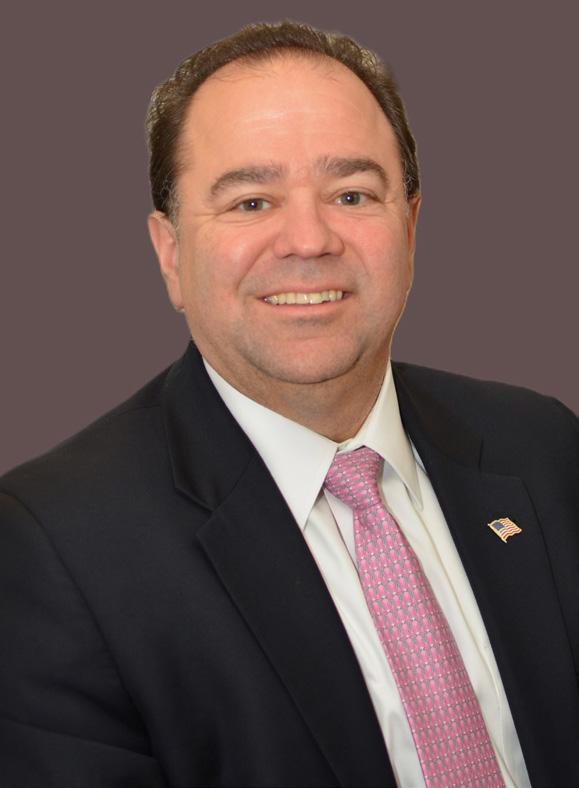
“We are delighted to welcome Scott to the TrechIT Solutions family,” said Dan Nudelman, CEO of TrechIT Solutions. “His extensive experience and strategic vision will be instrumental in propelling our company forward as we continue to revolutionize healthcare IT support and deliver exceptional service to our clients.”

April 2024 | TechNation 27
Scott Nudelman
INDUSTRY UPDATES
TECHNATION INVITES 40 UNDER 40 NOMINATIONS
TechNation is once again highlighting the next generation of HTM leaders with its third installment of the its 40 under 40 powered by YP at MD. The process of accepting nominations and applications is underway. Help shine the spotlight on the best young biomeds in the field!
Last year’s 40 under 40 class was filled with a diverse collection of accomplished young professionals and it was an honor to highlight them for all the outstanding work they have accomplished in the HTM industry.
It is exciting to see the nominations each year and there is great anticipation to find out and share information about the next wave of intelligent, creative and hardworking professionals.
Please help TechNation and the YP at MD in their efforts to recognize and boost the HTM profession. If you
JESSICA CURTISS JOINS MW IMAGING
know an HTM professional worthy of nomination for the 2024 40 under 40 class, please apply at the link below. The deadline to apply is Friday, April 26.
TechNation thanks YP at MD for its support of the 40 under 40. The YP at MD is a group of young professionals in the HTM industry. It is a community that enjoys exclusive networking opportunities at MD Expos, HTM Mixers and on social media. It is an opportunity to share ideas and discuss everyone’s bright future in the HTM industry!
For more information about the YP at MD, visit 1technation.com/2024-40-under-40.
MW Imaging Corp. recently welcomed Jessica Curtiss as a business development executive. Possessing extensive knowledge and insight of the HTM community, her 10-plus years of industry experience will be a welcome addition to the existing MW Imaging team, according to a news release.
Curtiss’s role at MW Imaging is crucial for both maintaining strong relationships with existing clients and driving business growth, the release states. Her responsibilities include a focus on customer satisfaction, business development and strategic planning.
“We are thrilled to bring Jessica into our organization,” MW Imaging Corp. President Robert Grzeskowiak said. “We know she will bring incredible expertise to this role, and I’m confident she will continue to grow the company. I look forward to seeing the great strides she will make as our new business development executive.”
MW Imaging Corp., an ISO 13485:2016 certified company, is an ultrasound supplier offering nationwide repair, service, maintenance, distribution, and sales of diagnostic ultrasound systems, probes, and parts. For over 30 years, MW Imaging Corp. has provided cost-effective alternatives for ultrasound service and sales. Its facility features an in-house repair center, a conference center for training and extensive inventory of ultrasound parts and probes. It also offers free 24/7 tech support to the HTM community.

INDUSTRY UPDATES
40UNDER 40 YP AT MD 28 TechNation | April 2024
Jessica Curtiss




Offering one of the industry's most extensive inventories of accessories and parts with full equipment support.

Contract and non-contract services from CBET/CRES certified engineers that meet or exceed JCAHO requirements.



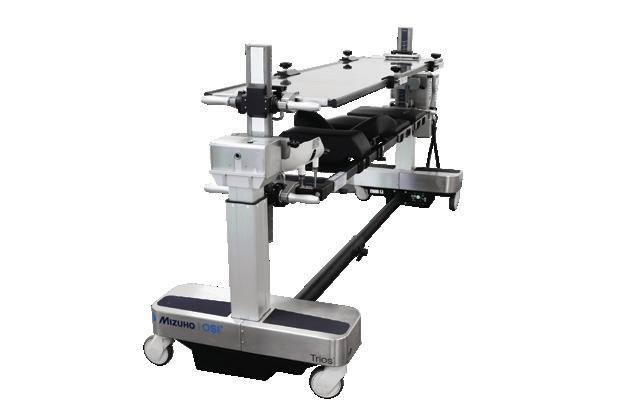




Offering a one-stop shop vendor neutral platform where customers can purchase different models up to 50% below the cost of new.

Established rental program that allows facilities long-tern, short-term, and rent-to-own options.
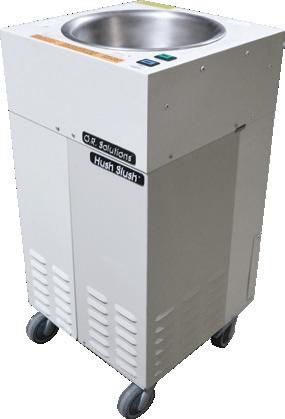

438-7662
info@somamedicalparts.com (800)
somamedicalparts.com @Somatechintl
SHOP FOR EQUIPMENT, ACCESSORIES, PARTS, AND SERVICE
ONE-STOP

ANNOUNCING THE LAUNCH OF
TV


Check out our Youtube channel for more information and exclusive content!
30 TechNation | April 2024








THE MEDICAL PRODUCT SUPPORT NETWORK Have a question about medical equipment? We Have Answers! Share ideas and information with other medical equipment professionals in our live Q&A forums. medwrench.com/forums
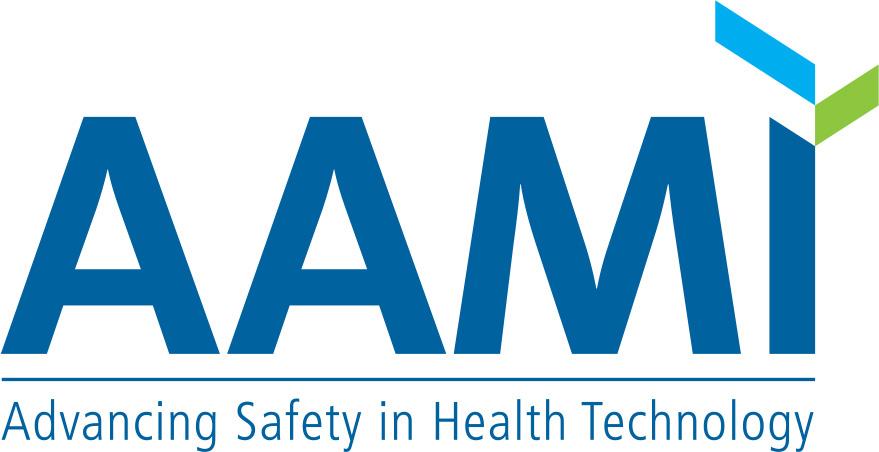
AAMI UPDATE
CDRH Reorganization Heralds New Focus on Medical Device Standards
The Center for Devices and Radiological Health (CDRH) recently announced a major organizational change. The Office of Strategic Partnership and Technology Innovation (OST) has been promoted to a CDRH Super Office, creating a new division dedicated to standards in the process.
“The Super Office designation allows the Center, specifically OST, to be well-positioned and capable of adapting to and addressing future public health needs and challenges while continuing to advance the voice of patients, innovation and safety, regulatory science, and service excellence with our customers,” CDRH Director Jeffrey Shuren stated.
As part of the reorganization, the Standards and Conformity Assessment Programs (S-CAP) has been promoted to division level and is now the Division of Standards and Conformity Assessment. Within DSCA there are two programs: Standards Management Program (SMP) and Conformity Assessment Program (CAP). DSCA’s new management team consists of DSCA Director Terry Woods, CAP Assistant Director Eric Franca and SMP Assistant Director Jianchao Zeng.
“The reorganization recognizes the importance of standards and conformity assessment to the Center’s mission and vision, assuring that patients and providers have timely and continued access to safe, effective and high-quality medical devices and safe radiation-emitting products,” Woods said. “We look forward to continuing to collaborate with SDOs and the entire medical device community in the development, recognition, appropriate use, and conformity assessment of voluntary consensus
standards for medical devices, radiation-emitting products and emerging technologies.”
“The creation of the DSCA is a unique and welcome opportunity for both AAMI and the entire standards development community,” added Matt Williams, vice president of Standards, AAMI. “The chance to continue and explore new collaboration with CDRH will certainly further AAMI’s mission of standards development with an eye towards optimal patient outcomes.”
Additionally, OST’s elevation comes alongside the establishment of a new Office of Readiness and Response (ORR). ORR’s mission is relevant to both AAMI’s membership and standards development committees, as it includes the development and implementation of new consensus standards for medical devices.
OST was founded in 2019, with the intent to “create an agile infrastructure capable of adapting to future organizational, regulatory and scientific needs.” Per the CDRH release, its primary functions include an external focus on issues such as “medical device cybersecurity, digital health, standards, and patient science,” and coordinating the Center’s readiness for crisis events such as pandemic outbreak or supply chain shortages.
OST’s new status as a super office has major implications for CDRH’s organizational structure, with the imminent establishment of five new offices inside of OST. These include:
• The Office of Supply Chain Resilience (OSCR) will lead the Medical Device Resilient Supply Chain and Shortages Program with an eye towards ensuring strong supply chains and addressing potential medical device shortages.
• The Digital Health Center of Excellence (DHCoE) will focus on the digital health environment, and the office will “connect and build partnerships to accelerate digital
INDUSTRY UPDATES
32 TechNation | April 2024
health advancement, share knowledge to increase awareness and understanding.” Further, DHCoE will “innovate regulatory approaches to provide efficient and least burdensome oversight while meeting FDA standards for safe and effective products.”
• The Office of Technology and Data Services (OTDS) will focus on executing CDRH’s Digital Transformation Initiative and ensuring the smooth use and handling of data by CDRH data both inside and outside the Center.
• The Office of Readiness and Response (ORR) will focus on issues such as cybersecurity, standards, and overall readiness with an eye toward hedging against public health threats. ORR will also “drive the development, recognition, and appropriate use of voluntary consensus standards for medical devices.”
• The Office of Equity and Innovative Development (OEID) will focus on health equity issues by “fostering device innovation that expands access to diverse patient populations, including underserved populations, and ensuring all patients have access to medical devices informed by solid patient science and engagement.”
The new Super Office will continue its existing partnerships with “various medical device stakeholders, including patient organizations, health care professional organizations, industry, and scientific and other organizations in the U.S. and abroad.” The office’s new structure is meant to boost the effectiveness of CDRH and ensure that CDRH can meet its strategic priorities and abide by its MDUFA V commitments.
HOW DATA SHARING CAN PROMOTE PATIENT SAFETY
In late 2023 the U.S. Department of Health and Human Services (HHS) issued a proposed rule that would implement financial disincentives aimed at health systems and health IT vendors that block electronic data sharing.
To better understand the recently finalized rule and its implications, AAMI News recently interviewed infectious disease physician and medical informaticist Dr. David Classen. Classen is a professor of medicine at the University of Utah in Salt Lake City as well as CMIO at federally certified patient safety organization Pascal Metrics. One of his primary focus areas is leveraging health IT to enhance patient safety.
Classen pointed out that the new rule, called the Health Data, Technology, and Interoperability: Certification Program Updates, Algorithm Transparency, and Information Sharing (HTI-1) Final Rule, has been released
by the Office of the National Coordinator (ONC), which as part of Health and Human Services, “oversee[s] the electronic health world that we live in.”
The rule directly targets information blocking, but also introduces new guidelines around artificial intelligence. But the penalties for health systems and vendors that obstruct electronic health information sharing could be steep, including Medicare impairments, a zero score for the Merit-based Incentive Payment System (MIPS), and ineligibility for the Medicare Shared Savings Program.
Why might health systems and IT vendors be hesitant to share data? Per Classen, “Health systems might not share it because they might be worried about data privacy and security if they share it outside their walls. They might be worried about competitive position if for example they’re one of just two health systems in a community.”
But Classen pointed out that the new rule builds on previous regulatory action. Further, even with concerns about data privacy, security, and competition among health systems and vendors, Classen indicated that the case for increased sharing of patient data is strong.
The new rule is meant to directly promote data sharing, something Classen believes is crucial for effective and safe patient care. “Let’s say I’m in my doctor’s office and my doctor’s about to prescribe a new medication for me that I had an allergic reaction to at another doctor’s office. I really want my doctor’s office to get that information, so they don’t give me the same medication … So that’s why information sharing is so important for the safe care of patients who often get care at different hospitals and different doctors’ offices.”
The conversation later turned to the value of health IT standards, particularly those developed by AAMI, in facilitating information sharing and ensuring patient safety. Classen highlighted AAMI’s efforts in creating safety software standards that apply to both vendors and users, and focus on areas like quality systems, risk management and usability.
“These standards are called life cycle standards and they’re a new thing. They’re developed so that we can give guidance to both vendors and users who are both customizing the software and help them create a sense of shared responsibility. And we believe that shared responsibility is what ultimately leads to the safest systems that we can possibly deliver.”
For more information, visit aami.org.
April 2024 | TechNation 33
RIBBON CUTTING
Vital Capital
Established in 2023, Vital Capital is an Orlando, Florida-based equipment brokerage firm and AACFB member. Led by owner Mary Pierce, who holds a finance degree from Tulane University, Vital Capital specializes in providing simple and affordable equipment leasing solutions. The mission is to make equipment finance accessible and profitable for everyone, offering 24/7 support for hassle-free, no-obligation leasing that maximizes profits.
TechNation recently found out more from Vital Capital Owner Mary Pierce.
Q: WHAT ARE SOME OF THE SERVICES AND PRODUCTS YOU OFFER?
A: At Vital Capital, we specialize in providing loans and leases for a wide range of equipment, catering to various industries including medical sectors and hospitals. Our offerings include low rates, deferred payments, no pre-payment penalties, and swift 24-hour approvals. With our special medical startup program, we offer doctors access to favorable rates based on their time in business calculated from their licensure date. Moreover, we assist medical companies in establishing international payment terms with their foreign distributors to enhance international sales volume. Our financing solutions encompass small ticket deals ranging from $20,000 to $200,000, and large ticket deals exceeding $1 million. Typical terms span from 24 to 60 months. For deals beyond these parameters, we provide tailored solutions. Additionally, we extend business lines of credit and offer invoice factoring services.


Q: HOW DOES YOUR COMPANY STAND OUT IN THE MEDICAL EQUIPMENT FIELD?
A: What distinguishes Vital Capital is our commitment to rapid financing approvals, competitive rates and personalized service. Unlike automated processes that often lack the human touch, we prioritize building meaningful relationships with our lenders, vendors, and clients, guaranteeing the best rates and programs for the end-clients. Furthermore, we recognize that end-clients are often confused about the financing process. To address this, our credit application process is designed with clarity in mind, featuring a walkthrough to clear up any confusion and ensure a smooth experience from start to finish. We’re always just a phone call away, ready to provide guidance and support whenever it’s needed most.
Q: WHAT IS ON THE HORIZON FOR YOUR COMPANY?
A: Looking ahead, our primary focus is on expanding our network of vendor partnerships. We aspire to become the go-to financial partner for equipment vendors, empowering them to close more deals by leveraging our streamlined financing process. By externalizing their financing needs through Vital Capital Financing, vendors can enhance their offerings and provide added value to their clients, all while closing more deals by solely focusing on their sales.
Q: IS THERE ANYTHING ELSE YOU WOULD LIKE OUR READERS TO KNOW?
A: Certainly! We are proud to offer a generous referral program that rewards those who recommend our services. For every successful referral that results in financing through Vital Capital, we happily provide a 20% commission, with a cap of $500, as a token of our appreciation. It’s our way of saying thank you for choosing Vital Capital Financing as your financial partner.
For more information, visit vitalcapitalfinancing.com.
INDUSTRY UPDATES
34 TechNation | April 2024


Who We Are
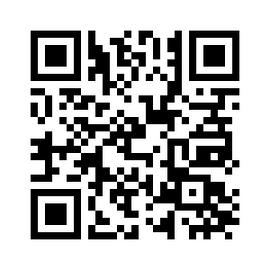

ELITE BIOMEDICAL SOLUTIONS
Our Offerings A s a n i n - h o u s e m a n u f a c t u r e r , E l i t e i s d e d i c a t e d t o p r o v i d i n g h i g h - q u a l i t y r e p l a c e m e n t p a r t s a n d s e r v i c e s f o r m e d i c a l d e v i c e s t o i m p r o v e p a t i e n t c a r e n a t i o n w i d e . W e a r e F D A R e g i s t e r e d a n d d u a l I S O C e r t i f i e d ( I S O 9 0 0 1 : 2 0 1 5 a n d I S O 1 3 4 8 5 : 2 0 1 6 ) r e s u l t i n g i n c o m p l e t e t r a c e a b i l i t y f r o m r a w m a t e r i a l t o f i n i s h e d g o o d s . Service Repairs Tech Support New Replacement Parts
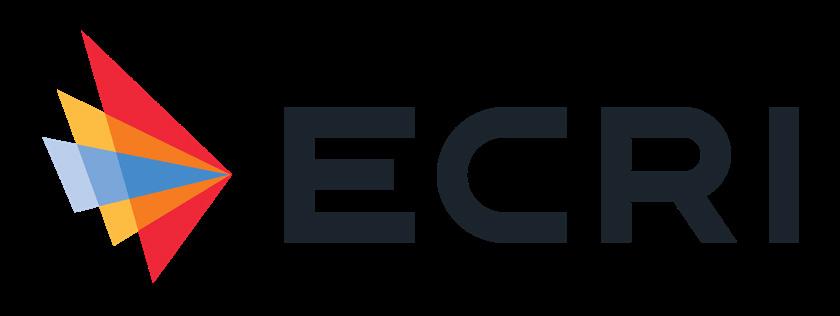
ECRI UPDATE
ECRI’s Top 10 Health Technology Hazards for 2024
roviding safe and effective patient care requires identifying sources of danger or difficulty with health technologies and taking steps to reduce the risk of harm. ECRI produces its annual Top 10 Health Technology Hazards report to help in this effort. The full report, accessible to ECRI members, highlights key technology management challenges and provides detailed recommendations to prevent adverse incidents. For non-members, an Executive Brief is available for complimentary download at www.ecri.org/2024hazards.
ECRI identified the following topics as warranting high-priority attention in 2024.
1. USABILITY CHALLENGES WITH MEDICAL DEVICES USED IN THE HOME
The trend toward providing health care in the home has led to the increased use of medical devices in that setting – including devices intended for use in a clinical environment (e.g., infusion pumps, ventilators). However, not all devices are sufficiently intuitive for home users to operate. Plus, the home setting can introduce environmental limitations (e.g., space restrictions, power issues) that impact device operation.
Severe harm can result if patients or their caregivers do not fully understand how to use a device and how to troubleshoot problems that arise. ECRI has encountered numerous examples of patient harm in this setting, including fatalities when a ventilator alarm failed to activate, and when a venous needle became dislodged during hemodialysis.
To minimize the risk of harm: Manufacturers should consider the needs of users when designing their devices that may be used in the home, and providers should select devices that are well matched to the patient and the environment of use, and provide the support that home users need.
2. INADEQUATE OR ONEROUS DEVICE CLEANING INSTRUCTIONS
Failure to properly clean and disinfect or sterilize reusable medical devices can lead to the spread of infection, device damage, and other forms of harm. Successful reprocessing is made more challenging, however, by the wide variation in the content, quality, and feasibility of reprocessing instructions. This puts patients at risk, as well as staff, who may suffer injuries from repeatedly performing onerous reprocessing steps.
ECRI recommends that health care organizations assess reprocessing considerations before purchasing reusable health care items. Favor products from vendors that provide practical, validated reprocessing instructions.
3. STERILE DRUG COMPOUNDING WITHOUT THE USE OF TECHNOLOGICAL SAFEGUARDS
Errors made when compounding injectable medications can have severe – sometimes deadly – consequences. Unfortunately, errors such as using incorrect ingredients or drug concentration are exceedingly difficult to detect once the preparation leaves the pharmacy.
While accurate compounding is important for all preparations, injectable preparations are of particular concern because of their need to be sterile, the frequency with which compounding is required, the opportunities for error, and the potential for significant harm. The use of technological safeguards, such as workflow management systems, can help minimize opportunities for human error.
4. OVERLOOKED ENVIRONMENTAL IMPACTS OF PATIENT CARE
Medical technologies play a lifesaving role in patient care, but their manufacture, use and disposal have a cost. These activities consume energy, release contaminants, and generate waste, adversely impacting the environment. This creates public health challenges – causing or worsening myriad health problems – and it exacerbates health inequities, since many of the health risks associated with environmental stressors disproportionately impact disadvantaged communities.
As protectors of public health, health care organiza -
INDUSTRY UPDATES
36 TechNation | April 2024
P

tions should examine ways to minimize environmental harm. The challenge is to do so without compromising patient care. Sensible strategies include reducing energy consumption in the imaging suite, choosing alternatives to the most harmful anesthetic gases, and eliminating purchases of extraneous single-use items (i.e., those that will be thrown away without being used).
5. INSUFFICIENT GOVERNANCE OF AI USED IN MEDICAL TECHNOLOGIES
Artificial intelligence (AI) functionality is being incorporated into a range of health care devices and systems – from workflow aids (e.g., automated scheduling software) to diagnostic support systems that interpret medical images or analyze a patient’s medical record. AI offers the promise of speeding up processes and assisting in clinical decisions. But AI systems are only as good as the algorithms they use and the data on which they are trained.
Instances have been reported of AI functionality contributing to harm, performing worse than advertised or providing misleading results. To manage this emerging technology, health care institutions need to establish an AI governance program that addresses all phases of technology adoption and use, from pre-implementation assessment to post-implementation monitoring.
6. RANSOMWARE TARGETING THE HEALTH CARE SECTOR
Health care organizations are attractive targets to hackers seeking to infiltrate IT networks (to extract a ransom payment) because of the value of their data, their critical need to restore operations quickly, and their limited resources for hardening defenses. Organizations need to implement measures to manage cybersecurity risks; but these measures aren’t foolproof, and many providers are overmatched.
Health care organizations need help from policymakers – for example, to address shortfalls in cybersecurity funding and expertise, to reassess penalty structures for
being victimized by an attack, and to strengthen law enforcement efforts at disrupting hacker networks.
7. INCREASED BURN RISK WITH SINGLE-FOIL ELECTROSURGICAL RETURN ELECTRODES
Adult patients are placed at unnecessary risk of burns during electrosurgery when single-foil conductive return electrodes are used instead of safer options. Single-foil electrodes do not engage an electrosurgical unit’s return electrode contact-quality monitor – a safety feature designed to detect when contact between a return electrode and the patient is compromised. When electrosurgery-related burns occur, insufficient contact between the return electrode and patient is a common cause. Safer alternatives include the use of dual-foil conductive return electrodes, capacitive return electrodes or other treatment modalities.
8. INFUSION PUMP DAMAGE – AN ONGOING MEDICATION SAFETY CONCERN
Infusion pumps are routinely subjected to conditions that can lead to damage, whether through mishandling, exposure to cleaning chemicals, or normal wear and tear. Such damage can affect the pump’s ability to accurately deliver fluids or medications, leading to dangerous medication administration errors. Furthermore, if the damage goes unnoticed or uncorrected, multiple patients can be put at risk. ECRI investigated one incident in which the absence of a key pump component (one that helps regulate the flow of medication) went unnoticed for several weeks. Staff need to be alert to the signs of damage.
9. POOR QC OF IMPLANTABLE ORTHOPEDIC PRODUCTS
Implantable orthopedic products range from simple bone screws, rods, and plates to complex knee and hip prostheses. Defects in these products can delay or prolong surgery or can lead to infection, persistent pain or other long-term harm. ECRI has received or investigated reports of incorrect labeling (which can lead to the selection of the wrong product), device-device incompatibility, missing components and breaks or cracks in the device. Improved manufacturer QC practices are needed to ensure safe and efficient patient care.
10. PATIENT CONFIDENTIALITY CONSIDERATIONS WITH THIRD-PARTY WEB ANALYTICS SOFTWARE
Third-party web analytics software can provide businesses with valuable insights about how customers use their websites. For health care organizations, though, analytics tools installed on patient portals and other provider websites pose a hidden risk. They can allow third-party companies to collect information that could reveal details about the patient’s medical condition. This information may allow companies to track patients’ online activity and target the patient with ads promoting remedies – possibly unproven ones – for the medical conditions disclosed.
ECRI members can access the full report of the 2024 Top 10 Health Technology Hazards at this link. https://ly.ecri.org/2024Top10Hazards.
April 2024 | TechNation 37


BIOMEDICAL When It Comes To CENTRIFUGES, One Name Stands Out • Free Tech Support • Depot Repair • Rental Units • Re-manufactured Parts • New Parts • Exchanges Your Centrifuge Solutions Center www.ozarkbiomedical.com 800-457-7576 VISIT OUR BOOTH! #509 38 TechNation | April 2024
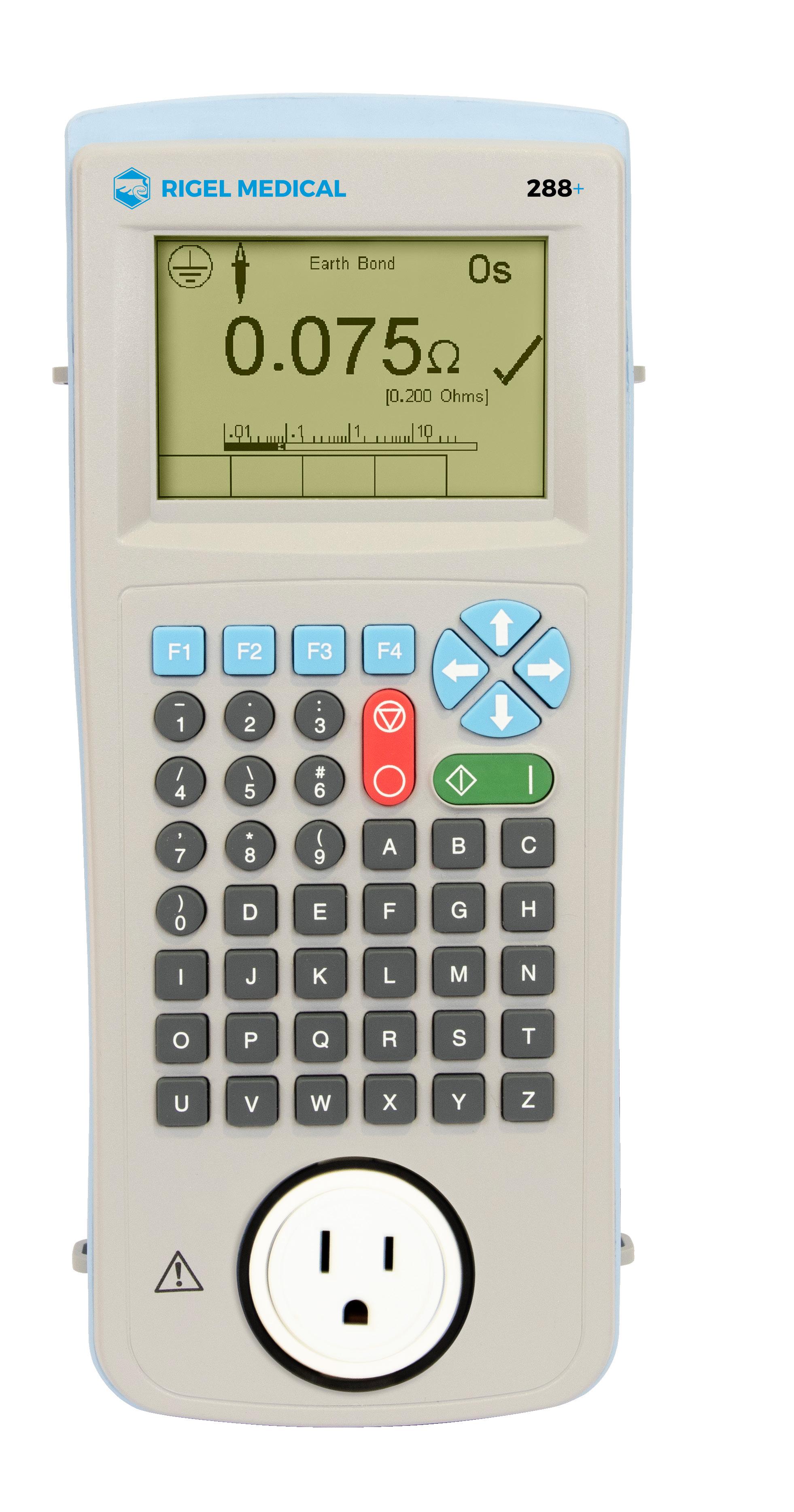
The Rigel 288+ is the first truly handheld medical electrical safety tester to combine the features of an automatic/manual tester with data logging and asset management capability. Operation is through a menu driven GUI. A 5,000-record memory and Bluetooth connectivity make this an effective mobile unit. Enjoy complete freedom to move around, without the need for mains voltage, thanks to battery powered test capability. Using standard AA batteries, tests can be carried out for insulation, earth/ground bond testing, and touch or point-to-point leakage current testing. The Rigel 288+ electrical safety analyzer offers an accurate and fast solution for meeting international and local safety standards, including: IEC/EN 62353, AAMI/IEC/EN 60601-1, IEC 61010, NFPA-99, AS/NZ 3551.
Key features include:
Automatic warning of secondary earth/ground paths.
Battery powered earth/ground bond, insulation and leakage
Accurate high current, low energy earth bond testing.
Bluetooth communication.
• Downloader app to transfer electrical safety test results directly from the unit to a smartphone or tablet. For more information, visit rigelmedical.com.
THE BENCH
288+ Electrical Safety Analyzer LIVE DEMO: April 3 at 2PM ET Registration on WebinarWednesday.live. Eligible for 1 CE credit from the ACI. April 2024 | TechNation 39
TOOLS OF THE TRADE Rigel

BIOMED 101
What vs. Why – Capitalizing on Learning and Experience (Part 2)
BY DALLAS T. SUTTON
WMENTORSHIP
ithout a doubt, your most valuable resource when developing experience is those that have it. So, how do you capitalize on the experience you currently have?
The first and most financially profitable way is to keep it. Create an environment where experience is recognized, respected and even occasionally honored. Those with experience have either been with you, or been in the field for a while, and have seen both leaders and technicians come and go but are still pulling their fair share of the workload for you.
Unfortunately (or fortunately depending on which side of the hill you are on), people will depart your organization. Ideally, you will not be the cause, but regardless, people will move on for any number of reasons. You want to make sure you foster an environment where your staff are comfortable in coming to you with their plans without fear of repercussion. Sometimes people of non-retirement age are faced with life changes that mandate a move – do not penalize
them, instead work with them in order to get as much notice as possible that you use to both hire a replacement, and/or to pair them with a potential replacement to transfer as much knowledge as possible. Those that are retiring should have no problem in giving you many months of notice that you can use to great advantage from a formalized training and mentorship perspective.
Most effectively, you don’t want to wait until someone decides to leave to begin some form or mentorship. This should be something continually at top of mind. A cursory review of your inventory by modality can quickly tell you where you need technical depth when weighed against service history and active contracts. If your department fully supports CT, it should be obvious, regardless of the number of CTs you have, that you need more than one trained engineer, just to support on call and vacation functions, not to mention other absences, site to site travel requirements and an install base greater than one. This applies to any number of modalities on the biomed and imaging sides of the house.
So, we want to keep experience, want our staff comfortable with us and want depth at the modality level – all pretty obvious – but what does it take to accomplish this?
TIME
The most painful part of a mentorship program is the time it takes to create experience. Although part of it, a mentor
THE BENCH
40 TechNation | April 2024
can’t simply explain a problem and a solution to a mentee – the junior technician has to experience it for it to be hardwired as their own unique knowledge. In addition to redundant formalized technical training, you will be sending two technicians to perform tasks normally required by one. This will need to occur during the most inopportune times, require overtime, will burden other members of the team, and may require salary adjustments. If you are asking your seasoned technicians to train junior team members, they need to feel comfortable in doing so, not threated by “competition.” They need to know they are not wasting their time (as evident in your efforts to retain and continue to develop the less experienced). Mentoring is an additional duty – their normal job isn’t going away – is it something you should consider a compensation adjustment? Is there some other benefit you can offer like lesser call responsibility?
Mentorship is best accomplished as a formalized process, but this is not always possible based on staffing levels, timelines or availability of existing experience. At a minimum, you should make an effort to stagger your modality-specific capabilities. You don’t want two or more technicians with the exact same training or skill set – if you have one engineer who is CT and MR trained, another might be MR and NM and a third NM and PET trained. Set yourself up so that if someone leaves, you still have at least some level of depth for those affected modalities. Once again, what does this take? Time (and money of course).
FINAL THOUGHTS
While we will never achieve 100% efficiency in the retention of knowledge and experience, we should, at a minimum, work to remove the roadblocks that prevent or inhibit this transfer.
I’ve had the good fortune to be surrounded by those who work very well together. Both the mentor and the mentee feel as though they have the autonomy to engage in the exchange of experience at will. My seasoned engineers have the authority to pull more junior technicians from assigned tasks when a teachable moment arises, and my junior technicians have the ability to engage the more seasoned techs to request insight for specific tasks. Recently, I found my most seasoned engineer holding a voltmeter for a very junior engineer. Mentorship being fresh in my mind, I inquired as to what was going on. To my dismay, they really didn’t know how to answer as the seasoned engineer had been assigned a time sensitive
task and was obviously not engaged in it – there was a bit of fumbling to come up with what they thought I wanted to hear. I had to stop them and told them to just tell me what they were doing. The junior was having trouble making a board level voltage measurement because of the physical location of a wiring harness – the senior was offering advice on the best way to access and the best tool for the job. On the spot experience transfer – exactly what I wanted to hear. I complimented them both, one for asking, one for answering, and let them know it was the right thing to do, regardless of other assigned tasks.
In a similar event a few days earlier, I encountered a group of technicians struggling with the operation of an oscilloscope and an unusual test requirement setup – we all know how infrequently we use oscilloscopes these days. In this instance, I was able to inject myself as the mentor and transfer some of my knowledge and experience to junior technicians. The most interesting thing was the reason the test was being performed. We had an early life tube failure, and while attempting to replace the tube not once, but twice. It was found that the tube would not calibrate and after the second tube, a more seasoned technician began to question their original diagnosis and was exploring other possibilities. Turns out it was a manufacturing lot of bad tubes and a tube from a different vendor and lot number solved the problem. This event was being managed by a more seasoned technician, working with a more junior technician, both OEM trained, but the more seasoned had more experience in more unusual tube related errors. The end result was that the junior technician got more troubleshooting insight from the more seasoned tech and learned a little about test equipment usage.
I encourage you to recognize the expertise currently at your disposal and proactively use it to develop the next generation using the tools described here. Invest the time in the creation of an effective repository of information that your most experienced can contribute to and your lesser experienced can draw from. Formalize your mentorship program as much as is possible in your environment and use it as a recruitment and retention tool – people want to know that you are willing to invest in them. Finally, really work on retention of talent. This is a hard row to hoe, especially when dealing with overtaxed budgets and an overtasked HR department, but as a matter of survival, it is a fight we must stay in. Make your department a place people want to be. Best of luck!
April 2024 | TechNation 41


All webinars, podcast, and product demos are eligible for 1 CE credit from the ACI.
CLICK. WATCH.

TOOLS OF THE TRADE: FSI’S CMMS PLATFORM
TechNation magazine’s Tools of the Trade live demo of FSI’s CMMS was sponsored by FSI and eligible for 1 CE credit from the ACI.
In the Tools of the Trade LIVE Demo attendees were able to learn how to optimize a hospital’s biomed and HTM operations with FSI’s CMMS platform. FSI Solutions Engineering Manager Mike Zimmer and Director of Product Experience Joe Stockman shared how to deploy a comprehensive, standardized, and scalable cloud-based software purpose-built for health care professionals. With tools to standardize asset categories to keep inventory accurate to compliance-focused features that help your team stay compliant, FSI’s suite of products empower users with complete, usable, and useful data – just one click away.
As Webinar Wednesday’s 10th anniversary celebration continued, Adam Treslan of Mary Greeley Medical Center in Iowa was the latest winner of a pair of Apple Airpods. Prizes will also be given away at upcoming webinars.
FSI was pleased and thankful for the opportunity to connect with the TechNation community via a webinar.
“Thank you so much for helping to make today’s demo a success! We think it went really well and we were pleased to see so many attendees,” FSI’s Claire McDonald said.
Attendees were just as pleased. They were asked, “What was your single biggest takeaway from today’s product demo?”
“On the floor plan showing devices and by the demo what items were due for PM,”
- Troy Hartman, BMET specialist, UPMC Western Maryland-BioTronics.
“I wish more hospitals had the funding to implement devices like these to make our jobs easier when looking for equipment,” - Logan Lozano, a senior tech with CommonSpirit Health.
For more information, visit WebinarWednesday.live.
WEBINAR HIGHLIGHTS INDUSTRY TRENDS
The recent webinar “Clinical Engineering: Navigating Industry Trends” was sponsored by TRIMEDX and eligible for 1 credit from the ACI.
Clinical engineering has evolved over the past 10 years. In this webinar, TRIMEDX Senior Talent Acquisition Partner Sarina Malik and TRIMEDX Director of Workforce Strategies Courtney Kinkade shared some industry trends, including:
• how companies are utilizing non-traditional talent when hiring demands outpace the availability of CE experienced talent;
• the increasing need for CR talent to be savvy in cybersecurity/IT and how TRIMEDX is meeting that demand; and
• how candidates can best position themselves for optimum success in their job search.
Webinar Wednesday once again gave away a pair of Apple Airpods as it continues to celebrate its 10th anniversary. Logan Lozano, a senior technician with CommonSpirit Health in Texas won the Airpods.
After the webinar, attendees were asked “How much new information did you receive from today’s webinar?”
“Great job of explaining the issues with getting new BMETs, how to expand your search for techs that can become a BMET, and then what hiring professionals are looking for on your resume. Great job,”
- David Braeutigam, Collin College Professor

WEBINAR EXPLORES X-RAY METER ADVANCES
The RTI-sponsored Webinar Wednesday session “Revolutionizing X-ray Meter Technology: Mako – A Meter and a Milestone” was a popular choice for HTM professionals. Eligible for 1 credit from the ACI, the webinar provided great insights along with credit toward certification.
Since its groundbreaking inception in 1982, when RTI unleashed the world’s inaugural non-invasive kV and dose meter, advancements in detector design have improved, shrinking in size, while becoming faster and more precise. Despite these advancements, the overarching design principles governing non-invasive kV and dose meters had steadfastly clung to tradition for a staggering four decades – until now. At RSNA 2023, RTI unleashed the Mako – a seismic shift in X-ray meter design. RTI once again propels the boundaries of innovation, setting the stage for a new era in the realm of X-ray meter technology!
RTI’s Erik Wikström explained the hardware structure of the next generation X-ray meter and how software contributes to the shift into a new era for HTM professionals, physicists and QA regulatory teams.
As Webinar Wednesday continues to celebrate a decade of delivering educational sessions to the HTM community a pair of Apple Airpods were given away! Ryan Barrie, BMET II, with TRIMEDX was the lucky attendee who won the Airpods.
After the webinar, attendees were asked “How did today’s webinar meet your expectations?”
“This was my first webinar, and it was a lot more information than I realized, but it wasn’t overwhelming. I was interested and engaged, and I found myself pondering about it even after it ended,” - Lula Deng, student, MSCS.
Watch these webinars on-demand
EARN. trimedx.com rtigroup.com fsiservices.com
42 TechNation | April 2024
CONGRATULATIONS TO THE TECH CHOICE AWARD WINNER
ASSOCIATION OF THE YEAR
Florida Biomedical Society

“The Florida Biomedical Society truly deserves recognition and an award for their exceptional contributions to the field. Their annual symposiums are not only highly informative but also incredibly engaging and consistently attracting a diverse and substantial audience. What sets them apart is their commitment to creating a family-friendly atmosphere. Beyond their academic pursuits, the society’s members actively participate in community initiatives, showcasing their dedication to giving back. With their substantial reach and impact, the Florida Biomedical Society stands as a prominent and influential force in the biomedical community. Their unwavering commitment to education, inclusivity, and community engagement makes them a deserving recipient of this esteemed award.”
- Myra Becerra, Biomed Supervisor, Memorial Healthcare System
SPONSORED BY:

888-492-3400 multimedicalsystems.com
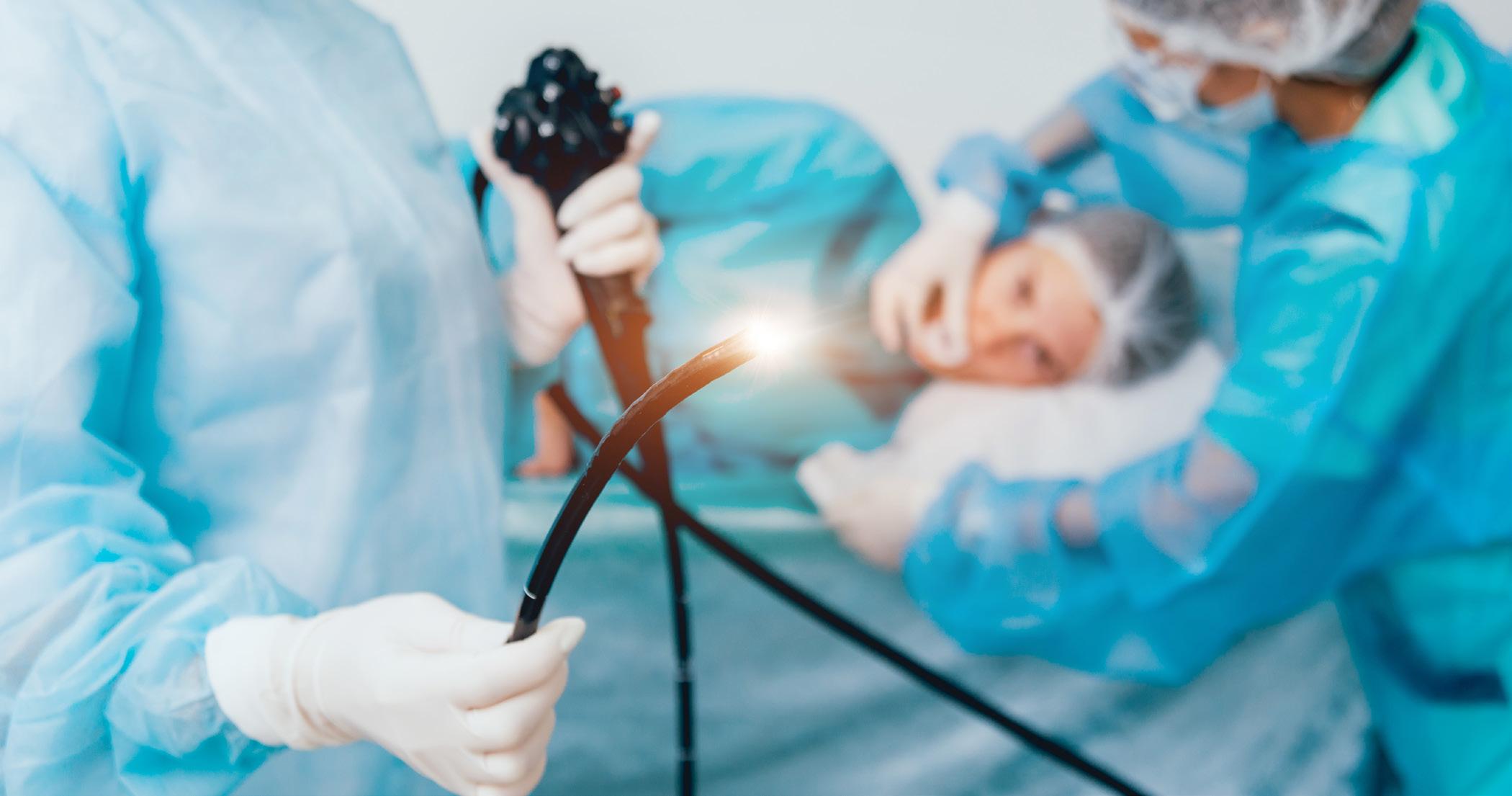
ROUNDTABLE Endoscopes
TechNation invited endoscope experts to share their knowledge with readers in this Roundtable article.
Participants who agreed to share their knowledge are:
• Fibertech Medical Partner Frank Majerowicz
• Agiliti Director of Customer Training and Education Mike Matthews
• ECRI Principal Project Engineer
Mairead Smith
• Healthmark Industries (a Getinge company) Clinical Education Specialist John Whelan, BSN, RN
HOW HAVE SINGLE-USE ENDOSCOPES IMPACTED HEALTH CARE FACILITIES AND BIOMED DEPARTMENTS?
MAJEROWICZ: In my opinion single-use endoscopes can be a great option as back up to standard endoscopes and for use with difficult procedures that may increase the possibility of damage to a standard endoscope.
There could be a growing opportunity in ENT and urology procedures. However, I do not see single-use endoscopes impacting GI endoscopy anytime soon.
MATTHEWS: While reusable endoscopes are still the most frequently used, single-use endoscopes have gained traction particularly within urology clinic practices because of recent manufacturer recalls and standards that require sterilization, as well as growing infection concerns. Disposable, single-use endoscopes offer a sterile solution that fits well with high patient turnover, but they are typically not the most cost-effective option.
SMITH: Single-use endoscopes have gained traction in the last five or so years. ECRI sees many health care facilities using a combination of single-use and reusable models – even within a given scope type. While this offers many advantages for clinical workflow, reprocessing procedures, and infection prevention, it can also add complexity in other areas. For example, facilities need to ensure that clinical and technical staff are adequately trained on proper use of every model, and that accessories and consumables are stocked for each platform.
ROUNDTABLE
44 TechNation | April 2024
WHELAN: The availability of fully disposable and partially disposable (i.e., single-use endcap) flexible endoscopes have provided alternate options to address long standing concerns re: the limitations and risks of manual and automated processing for these high-risk reusable medical devices. Reducing or removing the need to process all or part of the scope then lessens or removes work for both processing departments as well as HTM staff. The related use of single-use accessories (buttons and valves) with reusable endoscopes as well offers risk mitigation. In the U.S., there is widespread variation in the adoption of single-use endoscopes. Some clinical departments (e.g., anesthesia or respiratory therapy) may shift to predominantly using single-use scopes. Some GI endoscopy departments may opt to reserve the use of disposable scopes for select procedures (e.g., ERCP) or higher-risk patient populations.
WHAT STEPS SHOULD BE TAKEN WHEN LOOKING TO PURCHASE ENDOSCOPES?
MAJEROWICZ: Many health care facilities now consider pre-owned endoscopes as a cost-saving alternative to buying new. While in general a pre-owned endoscope will cost approximately 50% less than buying new there are important points to consider such as: 1. Trust the company you are purchasing from. 2. Ensure the endoscope was inspected and repaired prior to purchase (note there are companies that “flip” endoscopes without proper evaluation) 3. Confirm the warranty and what is covered. 4. Cheaper is not always better – because of the high cost of endoscope repairs you need to make certain the scope you purchased is in good working order.
MATTHEWS: Because of high capital costs, hospitals often purchase the minimum number of endoscopes necessary for their current procedure loads, which doesn’t account for procedure growth or a spike in cases. Lack of stock puts increased pressure on reprocessing staff to turn scopes faster, which creates more opportunities for damage and makes preventive maintenance very difficult. Combined, these factors can quickly lead to excess, avoidable service and replacement costs. The full spectrum of endoscope care should be considered in the initial purchasing process, including needed investments in education and process improvement measures.
SMITH: When selecting endoscopes, facilities should first identify which types of endoscopes need to be replaced and define clinical and technical requirements for these products. To obtain best pricing, look for opportunities to standardize across clinical areas (e.g., selecting the same manufacturer for both pulmonary and gastrointestinal
scopes, or for both single-use and reusable scopes) and use a benchmarking service to identify potential savings. Consider what level of service coverage will best serve your facility – for example, full coverage is recommended for scopes that are used frequently, whereas risk-sharing or fee-for-service plans may be more cost effective for scopes that are used infrequently or require few repairs. And finally, negotiate for value-adds to service agreements, such as care and handling educational programs, scope tracking systems, loaners and nocharge delivery.
WHELAN: The first step would be to inventory any/all clinical customers – to categorize models and numbers of scopes needed. Administrative discussions re: whether to purchase or lease from endoscope manufacturers would happen coincidentally. Depending on the size of the “purchase,” a cost per procedure lease that includes repair allowances may make better financial sense for a health system. Diligent planning would include a search of the FDA M.A.U.D.E. database for reported issues related to certain brands or models. A proactive and inclusive project team would include multidisciplinary input from clinical users, processing professionals, infection prevention, HTM and administration.
HOW OFTEN SHOULD ENDOSCOPES BE INSPECTED OR HAVE A PM?
MAJEROWICZ: Routine endoscope inspections will insure they are in good working order, safe to use, and will help prevent unforeseen major repairs. There are some items that can be inspected by the clinical staff on a weekly basis that often are overlooked (such as chipping adhesive seals, chipped lenses and damaged insertion tubes). In addition, endoscopes should receive a qualified inspection every six months to insure proper and safe performance. At FiberTech Medical, we perform a full PM inspection every time an endoscope comes in for repair –regardless of the customer’s claimed issue.
MATTHEWS: Some endoscopes define a specific timeframe for required PMs, such as those used in ERCP procedures. However, in instances where a PM is not defined by the manufacturer’s IFUs, the health care facility should define its standard based on their unique circumstances. For example, a teaching facility will likely need their scopes PMed more frequently than a non-teaching facility. Once per six months is typically a good starting point, but if a repair analysis shows that most scopes are breaking in less than six months, more frequent PMs should be considered. Each facility should work with their repair vendor to evaluate their scope repair trends and determine the best fit.
April 2024 | TechNation 45




SMITH: Endoscopes should undergo inspection and preventive maintenance as recommended by the product manufacturer or as otherwise determined by a facility’s alternative equipment maintenance interval. IPM intervals can be determined by the number uses/reprocessing cycles (e.g., every 100 cycles) or by a maximum time interval (e.g., 6 or 12 months). In general, intervals may vary based on scope type, scope age, repair history and frequency of use.
WHELAN: PMs should occur minimally according to the frequency outlined in the Instructions For Use (IFU) from the endoscope manufacturer. Inspections should actually be integrated into the routine working flow of handling, clinical use and processing. Everyone who touches the scope should (minimally annually) have training and competency testing on how to inspect a scope, and what is expected if concerns are identified. More focused inspection should always occur (per IFU and national standards/guidelines) every processing cycle – as a unique step after manual cleaning. Best practices call out the need for enhanced visual inspection at this point - i.e., lighted magnification, and/or the use of a borescope. Cleaning verification testing for residual soil would also be part of this step. So, inspection is everyone’s responsibility, not just HTM staff.
WHAT ARE SOME OF THE NEWEST ENDOSCOPE FEATURES?
MAJEROWICZ: Olympus is about to launch its newest generation of endoscopes which will transition from xenon light to LEDs and advanced imaging capabilities. Other recent features include scope guide technology which provides for the position of the colonoscope
during procedure and dual focus technology for closer examination of tissue.
MATTHEWS: Technological features related to advanced light wave applications continue to grow to include amber light. Additionally, features that were once available as a sole function in many scopes can now run concurrently, allowing enhanced imaging and light feature groupings.
SMITH: With ongoing concerns about infection prevention and the challenges of closely adhering to recommended reprocessing procedures, single-use endoscopes are one of the biggest innovations of recent years. Single-use models are now available for most major types of scopes – bronchoscopes, duodenoscopes, ureteroscopes, etc. Manufacturers are recognizing the benefits and finding ways to tie in the best features of reusable models with the strengths of single-use models, such as by offering both single-use and reusable from the same manufacturer, or by incorporating single-use components, like endcaps for duodenoscopes. Other manufacturers are focusing on advancements in scope navigation and control – like with robotic bronchoscopy.
WHELAN: As referenced above, for several years now we have duodenoscopes with single-use endcaps and fully disposable endoscopes. Additionally, each generation of endoscopes offers higher definition cameras and image enhancements, as well as higher definition video monitors. More recent years have brought integration of AI software technology to the procedure room – to aid in diagnostic interpretation.
ROUNDTABLE
Mike Matthews Agiliti
Mairead Smith ECRI
John Whelan Healthmark Industries
Frank Majerowicz
Fibertech Medical
46 TechNation | April 2024
HOW CAN THE LIFE OF AN ENDOSCOPE BE EXTENDED?
MAJEROWICZ: Endoscopes can last 10 years or more with proper maintenance. The biggest threat to endoscope performance is fluid invasion so preventing this type of damage should be a top priority. Otherwise, the OEMs and FiberTech Medical can perform full refurbishments keeping an endoscope in use if the features of the endoscope series is meeting the needs of the user.
MATTHEWS: Our internal repair data has demonstrated that over 80% of endoscope damage is preventable through better care and handling practices. Education for users and reprocessing staff is critical to extending the useful life of endoscopes. Process audits are another tool to determine where damage is happening and how it can be prevented. Finally, preventive maintenance is essential to avoid catastrophic damage and ensure patients always receive the best standard of care.
SMITH: Reusable endoscopes are fragile and must be treated with care to minimize the risk of damage. Staff who are responsible for pre-cleaning, manual cleaning, reprocessing and drying procedures should carefully adhere to the manufacturer’s reprocessing instructions for use. Leak testing and inspecting with borescopes can help identify certain types of device damage before it worsens. In addition, scopes should be protected from damage during transport, and clinical staff should be trained on proper use of the device, including how to use various tools through the working channel without causing damage.
WHELAN: Again, this is the responsibility of everyone who touches the scope. Through proper handling during clinical use, and every staff member following best practices in all steps of processing, endoscopes can be more effectively maintained. This takes ongoing education, training, competencies and embedding inspections in the routine workflow. Elevating the level of focused inspection (inside and out) – to include borescopic examination of accessible channels allows for proactive versus reactive approaches to maintenance and care.
WHAT ELSE DO YOU THINK TECHNATION READERS NEED TO KNOW ABOUT ENDOSCOPES?
MAJEROWICZ: Endoscopes are fragile instruments and expensive to maintain but, with proper care and handling and a qualified service provider, repair expenses can be kept in check. About 80% of endoscope repairs are because of accidental damage and not considered normal wear and tear, so clinical staff education and monitoring damage trends are important.
MATTHEWS: Facilities often purchase new equipment without considering the full spectrum of requirements (and cost) to care for the device properly. Critical aspects, specifically reprocessing, can be overlooked and can lead to high incidences of preventable damage because of a lack of training and process gaps. If a facility’s current processes are already leading to damage, purchasing new endoscopes will not fix those underlying issues. Instead, costs will likely rise even higher as newer technology tends to be more expensive to repair.
SMITH: Before purchasing, ask manufacturers for reprocessing instructions for use (RIFU). Confirm that your facility has the equipment necessary to perform reprocessing, including compatible automated endoscope reprocessors or liquid chemical sterilizers. Also, readers should expect ongoing changes to the endoscope landscape as the market for single-use models continues to evolve.
WHELAN: Unfortunately, all too often clinical departments only have “just enough” scopes in inventory – with no cushion when scopes are sent for repair. HTM – along with processing professionals and infection prevention – can help advocate for more appropriate inventories. Additionally, such multidisciplinary advocacy is needed to make the case for embedding routine quality control when it comes to inspection. Owning (versus leasing) scopes potentially adds risk in that scopes kept in clinical circulation longer are more likely damaged – even from normal use.
**HELP WANTED**

• A niche job board for the HTM and imaging communities powered by TechNation.
• 2800+ actively looking biomedical and imaging professionals.
• Completely FREE and confidential registration and application process.
• The fastest growing HTM talent network in the country.
• 350+ open opportunities throughout the United States.
• A variety of posting options ranging from single-job postings to 12-month unlimited memberships.
IS THE FUTURE
YOUR DREAM JOB AWAITS
HTMJOBS IS THE FUTURE
NICHE JOB BOARDS
IS THE FUTURE
HTMJOBS
HTMJOBS

HTMJOBS
NEW JOB OPPORTUNITIES
FIND YOUR PASSION HTMJOBS IS THE FUTURE
IS THE FUTURE
WANTED**
LESSONS LEARNED IN LEADERSHIP GETTING THERE AND MAKING A DIFFERENCE
BY K. RICHARD DOUGLAS

Investment banker J.P. Morgan, who was a dominate figure on Wall Street before the Great Depression, once said: “Go as far as you can see; when you get there, you’ll be able to see farther.”
Ray Kroc, who purchased McDonald’s in the 1960s and was its first CEO, said: “The quality of a leader is reflected in the standards they set for themselves.”
Both of these insights speak to qualities a leader requires; the vision to set goals and picture outcomes and the integrity and ideals that he or she ascribes to.
Some people in leadership are just naturally gifted that way and others find a mentor who has achieved success in this role. Others take formal coursework and earn degrees that are the basis for advancement into manager positions.
There is not one profession that could exist without leaders. HTM is no exception.
Somebody has to take ownership of the projects that the C-suite assigns to them, and somebody has to manage the day-to-day goals, assignments and responsibilities that influence the direction and accomplishments of the team.
While not all members of the HTM profession aspire to enter management or senior leadership, others have a roadmap in mind with leadership as a career goal. To aid in charting that roadmap, this article includes insights from leaders regarding what they have learned and how they entered their roles.
If you are one of those biomeds who aspires to leadership, read on and benefit from the insights of several members HTM leader.
“Leadership is a gift to be treasured. It’s an
COVER STORY
50 TechNation | April 2024
honor and a responsibility that should be held in high regard. Cherish this role, as it is bestowed upon you not just as a position, but as a testament to your capabilities and trustworthiness,” says Bryant Hawkins Sr., site manager for TRIMEDX at Children’s Hospital of New Orleans.
He says that it’s a privilege that demands the right mindset and approach. Handle it with care, integrity, and respect, for it can be short-lived if not handled with the right values and dedication.
QUALITIES OF LEADERSHIP
Leadership qualities are not learned all at once or taught in totality in a classroom. Many leaders, including those in HTM, have gleaned lessons over many years in their positions. They have taken lessons from those who have gone before them and learned many others firsthand.
“Leadership to me has taught me that it is not about you personally, but your team that you lead. There is a bigger picture to embrace in technology management of medical devices. By embracing your team’s skills, and getting your teams trained, is critical to garner the trust you need as a leader into your team. Being engaged with your team to understand the challenges they face. A good leader understands the business you’re in. They know when to make difficult choices to make operations streamlined,” says Adam Shannon, technology management senior manager at Banner Casa Grande Medical Center in Arizona.
manding/mean managers that are no longer around. It doesn’t feel great when you are in the middle of those situations, but as I look back now, they were just blips on the screen of my career,” Fedele adds.
The good qualities that a manager might seek in a technician need to be modeled by the leader.
“Transparency, availability and communication with team is vital. Building a culture of ownership, by being transparent, holding the team accountable by applauding wins and lessons learned and ownership starts with me,” says Monica Garcia, CBET, director of healthcare technology management at the South Texas Health System.
“Transparency, availability and communication with team is vital. Building a culture of ownership, by being transparent, holding the team accountable by applauding wins and lessons learned and ownership starts with me,”
- Monica Garcia
Jim Fedele, CBET, senior program director of clinical engineering, BioTronics, North Central and Central Regions for UPMC in Williamsport, Pennsylvania, says he is still learning. He says that as he works with a new generation of employees, he has had to learn to do things differently.
“That being said, the basics still apply; listen with purpose and over communicate. I feel like over communicating builds trust; I have experienced with both customers and employees,” Fedele says.
He says that he recalls one situation with an OR director; a crucial sterilizer was down and he was giving status constantly as HTM was troubleshooting the problem.
“We were stuck and I tried something that made it worse, but the director was fine because she knew we’re trying our best to fix the unit. We ended up getting all the parts the next day and getting it back in service,” Fedele says.
“The second important lesson I have learned is nothing lasts forever; good and bad. I think about great technicians I have hired that have left for other opportunities. Conversely, I remember all the spoiled physicians and de -

On the other hand, there may be a skill set that an HTM leader requires that is very different than that of a good technician.
“Skills that make a great technician are not necessarily ones that make a great leader. Skills like financial acumen, coaching and developing others, leading change, using influence, and delegation/ empowerment are all new skills that leaders have to be willing to learn and practice,” says Samantha Jacques, Ph.D., FACHE, AAMIF, vice president of McLaren Clinical Engineering Services (MCES) at McLaren Health Care in Michigan.
She says that technical leaders may not have been exposed to those skills as part of their background and training.
“Being open to developing new skills means being bad at them while you’re learning. Asking for help developing and growing these skills is hard to do, especially because as adults, it’s hard to start over and learn something entirely new. Being a good leader means being willing to continue to learn new skills and grow existing skills you have,” Jacques says.
In addition to the unique skills required of leadership, it also helps to be a good communicator, providing enriching and positive feedback and understand that your messaging has an impact.
“A key thing I have learned as a leader is the importance of Stephen Covey’s fifth habit, ‘Seek First to Understand, Then to Be Understood.’ Gaining a reasonably clear understanding about a situation or someone else’s viewpoint before providing guidance or feedback goes a long way towards effectively communicating,” says Jim Arnold, director, east region, biomedical engineering at Piedmont Healthcare in East Point, Georgia.
He says that it is important to explain the “why.”
“It is typically much easier to gain buy-in if you help folks understand why a certain decision has been made. They may not always like the decision, but understanding the ‘why’ behind it helps people grow and see things from


April 2024 | TechNation 51
“When people choose to follow you, not out of obligation, but out of respect and admiration, that’s when you know you’ve become not just a leader, but a source of inspiration and change.”
- Bryant Hawkins Sr.

which are different than those required for medical device calibration, repair and maintenance.
Shannon says that one good starting point is to take leadership courses.

“Many health care facilities offer Shared Leadership and other opportunities for team members to engage in leader activities. Engage in activities in your community. Be an engaged team member to show your direction is leader focused. Take on team members who may need guidance and teach and work with them for their success. Be a resident expert on your business. Show team members all aspects of service line so that they are versed in the work,” he says.
“Technicians can start by growing leadership skills that overlap their day-to-day jobs. Skills such as communication, being customer focused and driving execution are all good basic skills leaders should have,” Jacques says.
She says that working with your management to then take on more responsibility, such as leading a project, can also help expose technicians to skills for managing people.
“Technicians can also take courses in leadership from local colleges or associations such as the American College of Healthcare Executives. There are also a myriad of good leadership books available to help one independently grow leadership skills,” Jacques adds.
Hawkins says that as you progress, take on roles with increasing responsibility.
“Look for opportunities to lead projects or teams.

Participate in leadership development programs or workshops. Learn about strategic planning, team management, budgeting and decision-making. Join professional associations such as the Association for the Advancement of Medical Instrumentation (AAMI) or your local HTM Association. Attend industry conferences like AAMI eXchange or MD Expo, workshops and seminars to stay abreast of the latest trends and technologies in health care,” he suggests.
“My first advice would be to act like a leader. Leadership does not always require a title of a leader,” Arnold says.
He says to then let your manager and those above the manager know of your interest to grow into a leadership role.
“Find someone who will agree to be your mentor. Bring potential solutions to your leader when challenges arise to develop and demonstrate your critical thinking skills,” he says.
Arnolds says to also learn what formal education is required to meet the requirements of the role you are seeking and pursue that education.
Jacques agrees that informing existing leadership of your goals is important.
“Discuss your desire to learn more about leadership with your direct supervisor and department leader. They can help identify opportunities for you to grow your career and take steps to help develop your skills,” she says.
Jacques suggests that individuals get a mentor and work with them on growing a specific skill they want to work on.

52 TechNation | April 2024

This mentor should not be a direct manager, as they will want someone impartial to help them identify strengths and weaknesses
INTENTIONAL OR NOT: EXPERIENCE IS THE GUIDE
Good leaders can recall humbly the lessons they learned through direct experience early on their road to becoming managers.
Fedele, who has been in leadership since the mid-1990s, recalls a time when he unilaterally made an executive decision that didn’t go over well. It happened when he was promoted from lead tech to
“I was excited to remove all the barriers that my coworkers and I complained everyday about. One item in particular was visiting every department daily and signing a ‘biomed book.’ It was a little bit of a pain because the departments would often move the books or throw them
Fedele remembers that everybody complained about how frustrat-
“Like a president the first day in office I decreed ‘we no longer needed to sign the book.’ My technician ‘friends’ threw me under the bus to the director in a minute, claiming I was setting them up to get in trouble with Joint Commission. The betrayal I felt stung for a while; I wasn’t prepared for the change in relationship status between me and the techs. However, this was a really good lesson, I learned that I needed to be sure to communicate and get input before making changes,” he adds.
The road to leadership may not always be intentional or planned.
“My path to leadership was unexpected. I was training my replacement as I was going to take on more of a field service role. During my training of a team member and walkthrough of the facility, my supervisor was let go. When I came back to the shop, I was informed that I would take on the interim leader role,” Shannon remembers.
He says that after being in that position for several years, he was made the permanent leader for the site.
“Now I am in my 24th year at this facility as the technology management senior manager. Seventeen of those years were as a leader. Now, I am committed to my team members and cannot appreciate them enough for their dedication and [the] hard work they provide under my guidance. Although it was not what I had intended, it ended up being one of the best overall outcomes for this facility and my team,” Shannon says.
Finally, when first applying for a leadership position, it may not work out right away.
“Stay positive even if you apply and interview, but don’t land a desired role. Avoid feeling sorry for yourself and just keep moving forward. I like to use young children as an analogy. How often do you see an infant fall down while learning to walk? Are those falls failures or are they incremental steps of growth? It’s all in how you choose to look at it,” Arnold says.
Hawkins says that when people choose to follow you, not out of obligation, but out of respect and admiration, that’s when you know you’ve become not just a leader, but a source of inspiration and change.


LEADERS IN HTM







JIM ARNOLD
Director, east region, Biomedical Engineering at Piedmont Healthcare in East Point, Georgia

JIM FEDELE
CBET, senior program director of clinical engineering, BioTronics, North Central and Central Regions for UPMC in Williamsport, Pennsylvania
MONICA GARCIA
CBET, Director of Healthcare Technology Management at the South Texas Health System
BRYANT HAWKINS SR site manager for TRIMEDX at Children’s Hospital of New Orleans
SAMANTHA JACQUES
Ph.D., FACHE, AAMIF, vice president of McLaren Clinical Engineering Services (MCES) at McLaren Health Care in Michigan
ADAM SHANNON
Technology Management Senior Manager at Banner Casa Grande Medical Center in Arizona
April 2024 | TechNation 53
CAREER CENTER Best Way to End a Job Interview
BY KATHLEEN FURORE
You’ve had what you think has been a great interview, and now it’s time to close the deal. What is the best way to end the interview? And even after you’ve summed up why you’re the right person for the job, should you still send a follow-up thank you?
It’s an important question, according to Cheryl Hyatt, a partner in executive search firm Hyatt-Fennell.
“The closing of an interview brings it all together and leaves your interviewers with their final picture of you,” Hyatt says. “Stumble at the end, and you may be passed over for a callback.”
The following tips can help prepare job seekers to wrap up interviews in a way that will leave a positive impression:
• Offer a short recap. Hyatt says this involves connecting the dots between your experience and the position. “Interviews cover a lot of ground. You not only do your interviewers a favor by recapping the most salient points, but also do yourself a favor by leaving them with a clear case why you are the best fit for this position,” Hyatt explains.
• Ask about the next steps in the process. This is a proactive way to end the interview and reiterates your interest in the position, according to Hardy Desai. founder and CEO of the digital marketing agency Supple. “Ask if there’s anything else they need from you to help with their decision and inquire about a timeline for their decision,” Desai says. “If you don’t already have their direct contact information, ask for a business card or phone number and email address so you can follow up after that timeline lapses.”
While applicants sometimes fear being too forward about their interest in landing the job, Hyatt stresses that it is important to be direct.
“Some candidates try to play hard to get and eschew letting an employer know how much they want a job. They fear ceding the upper hand in negotiations,” Hyatt says. “You don’t need to fawn or plead. Being clear that you are
interested in a position demonstrates that you are forthright and ambitious. A simple, ‘I hope to hear from you soon. I think this could be a winning partnership,’ is plenty to convey your desire for a position.”
• Leave on a personal note. That advice comes from David Ciccarelli, CEO of the vacation rental platform Lake, who says that approach will let you leave the interview on a memorable, warm note.
“Use the art of storytelling to connect yourself to the company. For example, you could say, ‘Thanks so much for meeting with me. This role would be a big win for me because I’ve loved using your products since I was 15,’ or ‘I’m excited to explore your employee resource groups tailored to my experiences,’ or ‘I’ve always wanted to work for a business that serves the community like yours does,’ ” Ciccarelli suggests. “Share those personal reasons that connect you deeply to the business.”
• Send a follow-up thank-you. “A candidate should always write a thank-you note following the interview. It may not need to reiterate the full extent of a previous discussion – it may simply serve to express gratitude and affirm their desire for the position,” Hyatt says. “A handwritten note is always a nice touch, but only if time is on your side. If you sense that a decision is imminent, definitely send your note via email within 24 to 36 hours of your interview.”
A follow-up might just be what puts you over the top in the hiring decision.
“A quick follow-up and thank-you call or email goes a long way, especially when recruiters are wavering between a few viable candidate choices,” Desai concludes. “It certainly won’t harm your chances, but it could help them!”
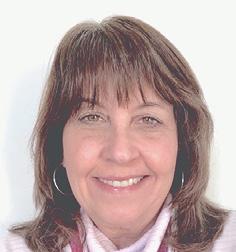
Kathleen Furore is a Chicago-based writer and editor who has covered personal finance and other business-related topics for a variety of trade and consumer publications. You can email her your career questions at kfurore@yahoo.com.
EXPERT ADVICE 54 TechNation | April 2024


All webinars, podcast, and product demos are eligible for 1 CE credit from the ACI.
LIVE:
ON-DEMAND:

sponsored by Cognosos
Tools of the Trade demo on ProPAR (Proactive PAR)
sponsored by Fluke
Next-Level Patient Monitor
Testing: Why it may be time to reevaluate your testing strategies
sponsored by Cynerio
Identifying Exposed ePHI: Finding Patient Data Before Hackers Do



APRIL 3 | Rigel
Tools of the Trade Live Demo
APRIL 10 | Healthmark
APRIL 17 | Kontakt.io
PODCASTS:




sponsored by MMS
Diversity in the Biomed Shop
sponsored by YP at MD
Girls on Fire: A YP at MD Podcast
webinarwednesday.live CLICK-WATCH
- EARN
$100 TUNE IN TO ANY LIVE WEBINAR TO WIN A $100 AMAZON GIFT CARD!
M C & K R ON FIRE YP at MD podcast
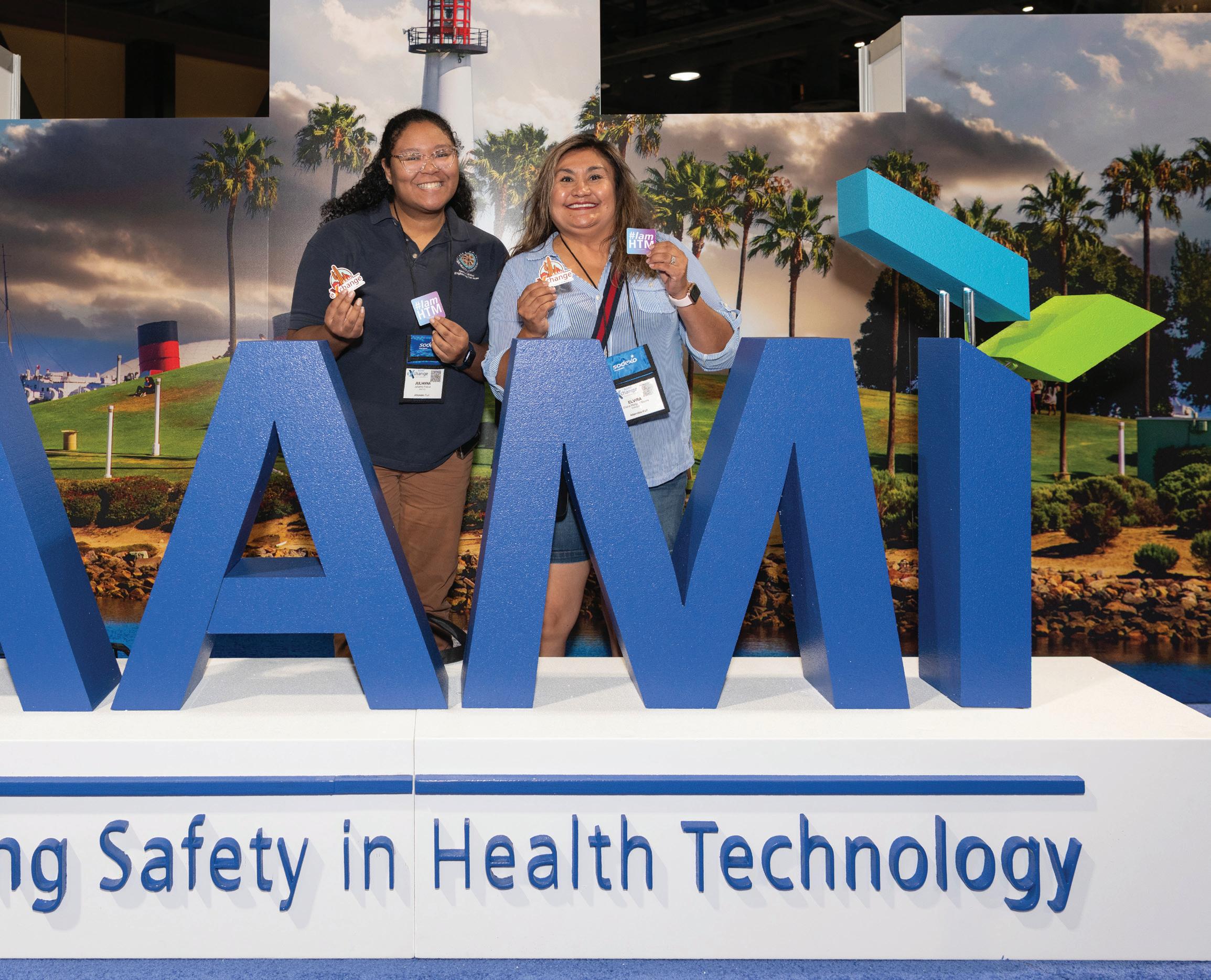


Where the entire field of healthcare technology management comes together to learn, connect with peers, and showcase the latest innovations, upgrades, and advances in health technology! JOIN US AT THE June 14 −17, 2024 Phoenix, AZ Register at www.aami.org/eXchange Early bird registration is open until April 5

NAVIGATING THE GOLD STANDARD:
Optimizing Welch Allyn Connex Spot Performance
BY SON NGUYEN, TECHNICIAN III
In the fast-paced environment of health care, having reliable patient monitoring equipment is paramount. The Welch Allyn Connex Spot Monitor stands out as a versatile solution suitable for various health care settings, from physician offices to ambulatory surgery centers. As a technician specializing in patient monitoring at Avante Health Solutions, I prioritize not only the initial deployment but also the ongoing maintenance and support of these critical devices.
THE GOLD STANDARD IN SERVICE
At Avante, we are proud to offer service excellence through the Gold License issued by Welch Allyn. This license empowers technicians with advanced tools and capabilities to ensure optimal performance and longevity of the Connex Spot Monitor.
Key Features of the Gold License:
1. Updates and Upgrades: Seamlessly install firmware updates and feature enhancements to keep devices up to date with the latest advancements.
2. Monitor Information Review: Gain comprehensive insights into installed modules, firmware versions, warranty details and usage history for effective management.
3. Maintenance Notifications: Receive timely alerts for scheduled maintenance tasks, ensuring proactive upkeep of equipment.
4. Remote Service Functionality: Connect with Welch Allyn Customer Service for remote assistance, firmware updates and software upgrades.
5. Worklist Creation: Efficiently manage service actions with customizable work orders, including calibrations, upgrades and license installations.
6. Scheduled Maintenance: Set service intervals to streamline maintenance schedules and uphold device performance.
7. Functional Verification: Conduct thorough tests on system components to ensure adherence to design specifications.
8. Calibration Verification: Verify and calibrate monitors as needed to maintain accuracy and reliability.
9. Device Recovery: Facilitate firmware reinstallation in cases of device boot failure due to corrupt firmware.
EXPERT DIAGNOSIS AND REPAIR
Our skilled technicians utilize the Gold License service tool to diagnose issues accurately and efficiently. From pinpointing the problem to executing necessary repairs, our team is committed to restoring monitors to their original specifications. Rigorous testing post-repair guarantees that all issues are resolved, reaffirming our dedication to excellence in patient monitoring.
CONCLUSION
In the realm of patient monitoring, reliability and precision are non-negotiable. With Avante Health Solutions and the Welch Allyn Connex Spot Monitor, health care facilities can trust in a partnership dedicated to delivering superior service and maintaining the highest standards of care.
For more information about Avante’s patient monitoring repair capabilities, call one of our experts at 800-449-5328 or visit avantehs.com.

Son Nguyen is a level III technician for the Patient Monitoring division, in San Clemente, at AHS. He has extensive experience in all monitor repairs and has been with AHS for seven years.
EXPERT ADVICE SPONSORED CONTENT April 2024 | TechNation 57
NETWORKING NOTES
Essentials of Network Troubleshooting
BY GARRETT SEELEY AND CAMERON LARKS
One of the things we have yet to cover in this series are techniques for troubleshooting a network. There are several different styles and approaches to troubleshooting networks. Here is a mash up of our techniques.
We prefer utilizing the first 3 steps of the OSI model, the physical layer, data link layer, and network layer. These are foundational to most network troubleshooting.
Check the physical cabling and the data link layer at the same time. To do this, check the link lights. NIC cards should have lights by the ethernet ports. Not all will, but if they do, the flashing light indicates that packets are going to the next device. Sometimes a solid light will indicate a connection, but on a two-light port, a blinking light indicates chatter. That means that the NIC is communicating to the switch. Most switches have a two-light configuration and will follow this pattern. No lights on the device means you do not have a connection. No lights on the switch usually means it is powered down. If the switch has lights but the specific port is not lit, then the cable may not be terminated correctly. This is the MAC address connection, or layer 2 connection of a LAN. To troubleshoot cable issues, a network connectivity cable tester should be used. To utilize this device, plug one side of the ethernet cable into the wall port and one side of the cable into the device. Once the device is on, it will verify if there is connectivity to a switch. If there is connectivity to a switch, the device will provide the switch information. If there is no connectivity, ensure the cable is plugged into the switch. This will activate the wall port. If the switch is responding correctly and connectivity to the network still fails, switch out the ethernet cable.
If the network is still not working, move to troubleshoot-
ing the network layer. Do this by breaking it up into two parts. First, check your IP settings. Use ipconfig/all. Ipconfig is a text command that lists the computer IP. It is hands down the easiest way to get the current IP settings of a Windows computer. It is not the only way, but it is the most convenient for a technician. Since it is a text command, ipconfig must run through the command prompt or PowerShell. These are the command line interfaces for a Windows machine. Command line is a way of controlling a computer through text. It is accessed through the “CMD” command through the “Type here to search” prompt in most Windows systems. Conversely, right click on a computer that you have administrative access to, select either Command Prompt or Windows PowerShell. These commands will work in either of these windows.
Using ipconfig will list the current IP settings for the system. Note: if a computer ever lists its IP as 169.255.???.??? (? Means any number). That is a dummy IP, called an APIPA IP address. This is Windows giving the NIC an IP just so the programs that require an IP to work can function. If there is no link light, this IP will be in the system. Verify step #1 is OK. If it is, verify the DHCP server or router is on for the subnet that you are on. Verify the system has an IP that works for the subnet. This brings us to the next essential tool.
If the IP is set correctly, troubleshoot it using ping. There is a way to check each of the standard network’s settings, IP, Subnet, Gateway, and DNS, using three pings. This is performed through command line using the ping command, ex. “ping 192.168.0.1”. Using Ipconfig from step #2, get the IP of the computer ethernet adaptor, its subnet, gateway, and DNS. Make sure to read previous articles on these settings for familiarity on these numbers and what they mean.
Ping #1 – Ping the gateway IP to verify that the computer has access to the subnet. This will verify that the IP is in the correct range for that subnet. If there is a time out, the IP and subnet settings need to be inspected to make sure the computer is in the correct network for your local LAN. Honestly, look for duplicate IPs at this point. A common
EXPERT ADVICE
58 TechNation | April 2024
mistake is to use another machine’s IP instead of a unique IP. Again, read up on these settings in the TCP/IP networking notes for more information.
Ping #2 – Try pinging a known IP outside of the subnet or LAN. This can be, for example, a PACS server or even an Internet IP such as 8.8.8.8. This verifies the path your subnet takes to leave its LAN and talk to the larger hospital intranet or the Internet. The use of this command will look like “ping 8.8.8.8.” If this fails, there is a problem leaving the current LAN to the next LAN. In this case, the problem is most likely past your router and in the connection to the next router. Keep in mind that if your LAN was intended to be separate from the Internet, this will verify that there is no connectivity to the Internet. Confused? Stay tuned for future articles on VLAN troubleshooting.
Ping #3 – Ping a name of an Internet site that is allowed on your network, such as www.bing.com. This may also be as simple as pinging your hospital’s web page or intranet site. If this does not work, your DNS is either powered off or you do not have access to a DNS. It’s not a big issue if your network does not use a DNS, but more and more hospitals do use their own DNS. Note that pinging a name should give a reply from a number. The purpose of a DNS is to convert from a name to a number. For example, pinging “amazon. com” may result in an response from 54.239.28.85. If the response says, “destination host unreachable,” the DNS
could be off-line, incorrectly set or even unplugged.
These steps are the foundations of troubleshooting. Remember to follow the OSI model layers. They are a great model for understanding where things can go wrong. Check them in order: check the cabling and link layer, the local settings on the system, and the overall connectivity using ping.
After years in the field, it is still surprising to us how many times the answer is just as simple as an unplugged cable. These even happen in a networking closet that was supposed to be secured. It’s proof that we all need to keep in mind the basics, because those skills are the foundation of any troubleshooting.

Garrett Seeley, MS, CBET, Biomedical Equipment Support Specialist, VISN 17: VA North Texas Health Care System, Dallas Veterans Affairs Medical Center.

Cameron Larks is deputy chief of biomedical engineering at VISN 17: VA North Texas Healthcare System.



Contrast Injector Training • 100s of Error Codes not found in OEM Lit • Online and Onsite Training Available • Training BMETs since 2008 • Up to $5,500 in FREE Parts, PM Kits and Service • Massive Troubleshooting Library WWW.MAULLBIOMEDICAL.COM | 440-724-7511 | STEVE@MAULLBIOMEDICAL.COM ON-SITE AVAILABLE April 2024 | TechNation 59

20/20 IMAGING INSIGHTS
3 Strategies for Addressing MRI Failures
JAMES ASHBAUGH, DIRECTOR OF BUSINESS DEVELOPMENT
Do you know what’s NOT covered under warranty and service contract in your MRI suite? More importantly, do you know how you’ll address failures as they occur?
The immediate answer, of course, is “Yes.” Consider the following.
Warranties and service contracts provide us with a sense of security that can, sometimes, be misleading. It’s easy to think that, because we have a warranty or service contract in-place, our MRIs are covered no matter what happens, and we’ll be back up and running in short order. However, what many of us might not know is that warranties and service contracts are very different from insurance. With warranties and contracts, you’re only protected under certain circumstances, and you’re not covered under others. Like with your car, warranties cover manufacturing defects or failures, not user error or preventable damage.
Scenarios involving user error or human slip-ups occur every day in health care facilities. Accidents happen. Here are a few examples, of service events that were NOT covered under a service contract, from several clients.
• While prepping for an MRI, a technologist dropped a large body coil cracking the housing and damaging the electronics.
• While performing a scan, a patient lost bladder control.
• The magnet was quenched because a ferrous object was pulled into the field and could not be removed.
• While lowering the patient table, an MRI’s coil system cable became trapped and was partially severed.
Whether a new MRI, covered under warranty, or an older model, covered under OEM contract, addressing the failures described above are, most times, the responsibility of the facility. It’s not new. Failures considered preventable, avoidable or attributed to trauma and/or misuse are often not covered by an OEM service contract and are definitely not considered valid under warranty. In the event that a single, preventable, failure IS covered, it most likely won’t be a second time. Understanding how and why out-of-pocket expenses occur and developing contingency plans for when preventable failures occur can have a huge impact on service budgets.
Let’s see how MRI coil failures relate to this scenario. Innovatus Imaging has a legacy in MRI coil manufacturing, and we provide coil restoration for several prominent OEMs. We’ve been servicing coils for over 30 years and have amassed a large amount of failure analysis data. Our data shows that the majority of MRI coil failures are a direct result of, or related to, mechanical damage or trauma. Over 35% of all coils present with mechanical damage due to trauma, and an additional 17% are RELATED to trauma and/or improper use. Less than 25% are actually related to random component failures or electronic tuning. About another 25% are related to normal wear and tear. Knowing that over 50% of MRI coil failures may not be covered

EXPERT ADVICE
60 TechNation | April 2024
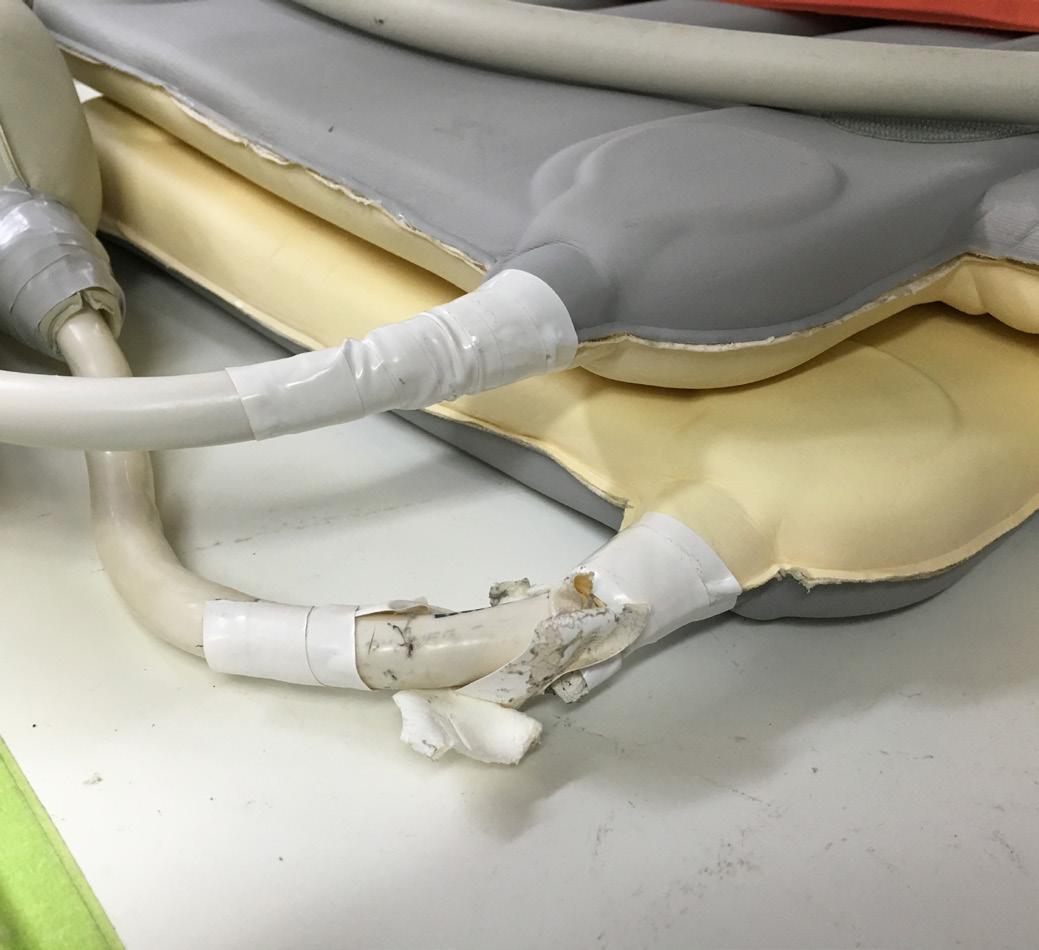

under your service contract should be reason to potentially rethink your service strategy for these devices.
Typically, when a coil fails, the OEM sends a replacement next day. It may take days or even weeks before an invoice is received highlighting preventable damage and the out-ofpocket expense. The HTM team may not even have visibility to the invoice. You may be surprised to learn that some OEMs install shock sensors within their coils to determine if the coil has been dropped or exposed to an unusual amount of force. So, even though there are no outward signs of trauma or mechanical damage, coverage may be denied.
The tough reality you have to face with most MRI contracts is that 50% of your coil failures may not be covered. Having to absorb an out-of-pocket expense of $35,000 to $100,000+ for a single coil failure can ruin any budget. At one point or another, we’ve all been asked, “Did you read the fine print?”
ANALYZE YOUR OPTIONS WHEN CONSIDERING A SERVICE CONTRACT ON YOUR MRI.
1. Full coverage SHOULD mean full coverage: Ensure that, if you have a service contract, that ANY and ALL failures are covered in the final cost. Costs will be high, but this option can ensure maximum uptime and continued workflow while eliminating out-of-pocket expenses.
2. Work smarter, not harder: Maximize your contract. If a standard OEM service contract is in-place, use an ISO 13485:2016 certified repair provider, such as Innovatus Imaging, to address any coil that shows evidence of preventable or avoidable damage. And, if there is ANY mechanical damage, do not assume that a replacement coil, through the OEM, will be covered. Address the failure via repair or non-OEM replacement using a qualified provider. Also in many facilities, not all coils are covered
under the MRI’s service contract. Be sure to understand exactly what IS and what IS NOT covered under your system’s service contract.
3. Eliminate coils from your MRI service contract: If your systems are not supported in-house, service contracts are a must to ensure uptime and continued workflow.
Knowing that over 50% of coil failures may not be covered provides some powerful information. Consider removing MRI coils from the service contract altogether. There’s a huge cost savings to be realized if managed properly. Coil repairs start as low as $500 and some repair providers offer loaners and/or expedited repairs.
The bottom line for any facility, large or small, is simple: When selecting a repair provider, be sure that repairs are performed with longevity in-mind. Ask about their length of time in the industry, quantity of repairs performed, and warranty period. All of which matter. For example, the team at Innovatus Imaging is applying experience from over 30 years and 40,000 plus coil repairs to define best-in-class repair processes and even help predict potential future failures. Ultimately, providers should demonstrate a dedication to quality by having ISO 13485:2016 certifications specific to the medical device(s) they support.
For more information, please contact JamesA@innovatusimaging.com.
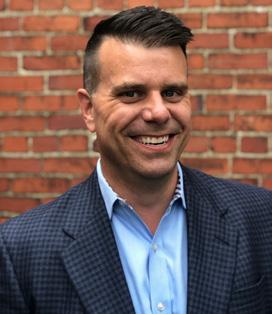
James Ashbaugh is the Director of Business Development at Innovatus Imaging and is a veteran in the HTM industry.
SPONSORED CONTENT
cable covered under contract Pulled/severed cable not covered under contract April 2024 | TechNation 61
Worn
THE FUTURE
Darkest Just Before the Dawn
ROGER A. BOWLES, MS, EDD, CBET
Progress continues within the biomedical equipment technology department at Texas State Technical College. Equipment is being shuffled around. Classrooms are being remodeled and changed. Classes are being aligned and changed. In short, times are tough. Hopefully, the dawn comes soon. I sometimes get a bit frustrated.
Let me explain. Somewhere, someone had a vision about a year or so ago and set the wheels of change in motion. First, the Waco campus library was permanently closed last year. The thought was that none of the students use it. So, it was converted to classroom and lab space. I have since heard many students complain about not having a library on campus. They say the only place they can study is in their cars. Quiet space is at a premium around here.
True, not many students check out books to read (or so I thought) and many periodicals are online. However, many of them used the library and some have asked about the copies of TechNation and other periodicals that we keep in our department. They like the print!
Next, our building is being renovated. All of our equipment is being shuffled around and the temporary labs we are using do not have enough electrical outlets (one on each wall). This was not well thought out. To make things worse, the boiler is out and has been for a month. We are using rental heaters in the classrooms. Good thing subfreezing days are not that frequent in Texas. Since the current labs are temporary, not much effort is being made to correct the conditions.
During renovations, recruiting is more difficult. Potential students coming through to tour the program are not impressed with the lack of organization and seeing equip -
ment stacked in various places. It sort of reminds people of a warehouse. I am sure we have lost potential students because of the chaos.
The vision is that there will be many more customized laboratories for our program and more newer equipment. I have heard the plans, and that part is definitely exciting. Getting there is the tough part. Delays in construction because of weather, lack of workers and unforeseen circumstances all have me wondering if the vision will still be achieved by the projected completion date. Like any “well-planned” project, I doubt it. But the goal, is for everything to be in place by the end of 2024.
Classes between campuses are being aligned so that each class is exactly the same at both campuses. That seems like a good idea except that not all of the equipment is the same and not every instructor wants to use the same exact material. However, in the end, this will probably make it easier for everyone. I am hoping the content becomes more stringent and not watered down so that one size fits all. However, I miss being able to change content on the fly as situations and conditions change without having to go through three layers of approval.
I miss the direct involvement we as faculty had with students during the advisement process. Every semester, students sat down with advisors who were faculty members in the department and planned their next semester or even their next couple of semesters. We knew their progress and their daily life challenges because we worked with them every day. Now, we have a separate department for advising.
We have always had a career services department here at the school, but most of the placement takes place through the department since faculty members usually have more contacts in the industry. We will continue to help students with placement.
Lastly, recruiting has always been an issue. In the past, our department took part in “road shows” where different programs at the college would set up in high schools around the
EXPERT ADVICE
62 TechNation | April 2024
state. That seemed to work well, and we gained many students from the road shows. At the present time, we are a bit undermanned in the department and the road shows have been discontinued for. Hopefully, we can get something similar going again soon.
All in all, the future is still bright. The temporary problems are just lasting much longer than I would like. On the bright side, we have two new faculty members directly from the field who are going to be superstars. They are enthusiastic, very knowledgeable and the students love them.
On a separate note, I have recently accepted a part-time, remote position with Texas A&M-Commerce as an adjunct faculty member in their competency-based Organizational Leadership Program. This program, and others in that department, will provide our students and other biomeds working in the field, an excellent opportunity to continue their education and earn a four-year degree remotely, while continuing to work and earn experience. Many of their credits from TSTC will transfer easily. Check them out at: tamuc.edu/college-of-innovation-and-design/#tamuc-section-74622.

Roger A. Bowles, MS, EdD, CBET, is a professor of biomedical equipment technology at Texas State Technical College.
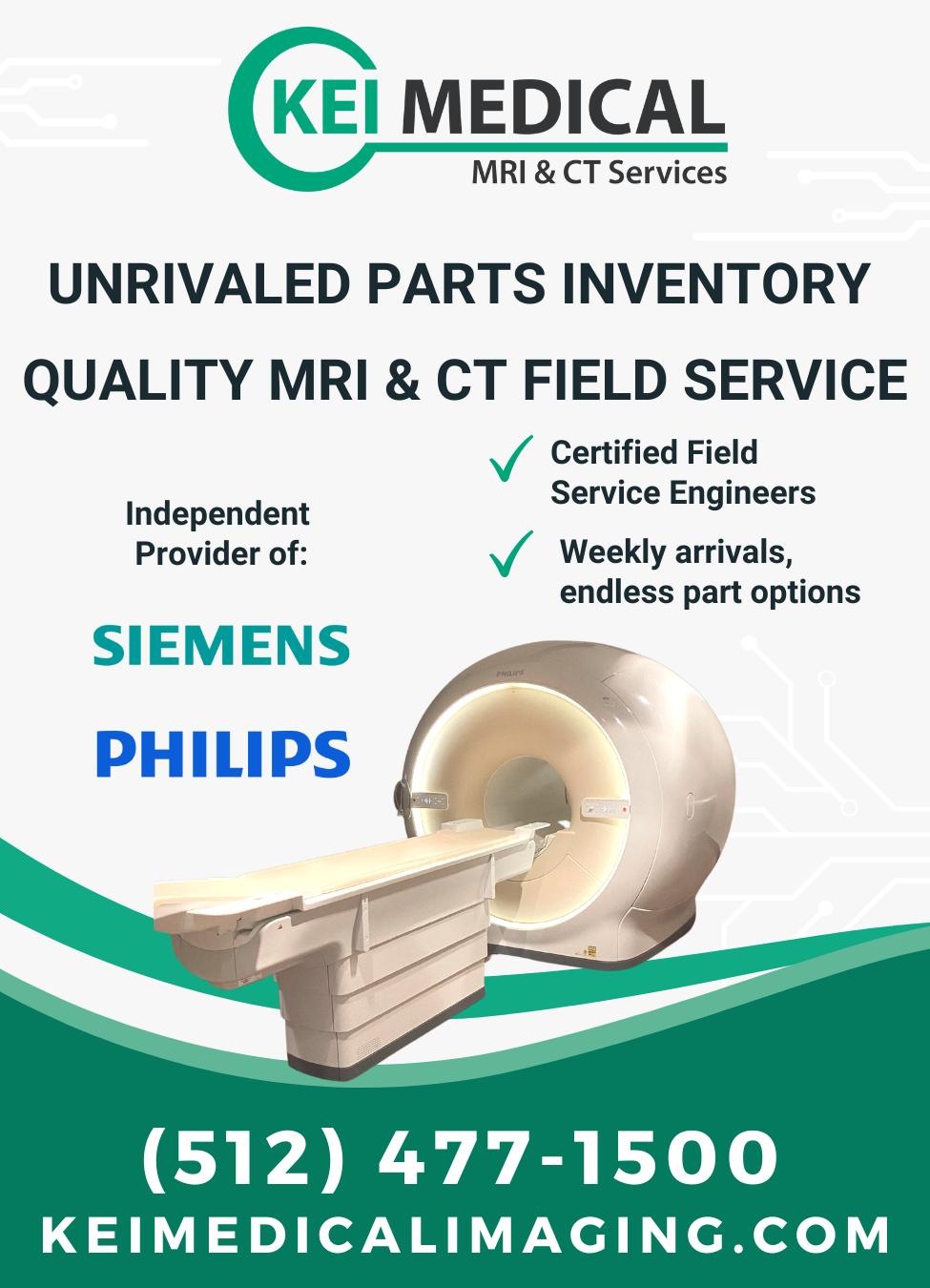

April 2024 | TechNation 63

HEALTHCARE UNDER SIEGE:
Battling Ransomware with Enhanced Proactive Defense and Advanced Technologies
Achilling reality for healthcare:
Entrusted with life-saving data and technology, it simultaneously faces an onslaught of cyberattacks, particularly ransomware. This alarming trend was highlighted by ECRI in their recent report, ranking “Ransomware Targeting the Healthcare Sector” as the SIXTH most significant Healthcare Technology Hazard for 2024.
According to a report by NBC Washington, an alarming increase in cyberattacks has been observed, with 60% of healthcare institutions falling victim to ransomware assaults within the past year. This stark reality underscores the critical challenge the industry faces in balancing its mission with the ever-growing threat of cybercrime. Due to their vulnerability and the valuable data they hold, healthcare organizations are often targeted by cybercriminals. A major challenge is the lack of robust cybersecurity measures, with many organizations prioritizing patient care over IT infrastructure.
As technology progresses, so do the methods of cybercriminals, making attacks increasingly dangerous. Data Breaches – Lead to identity theft through the theft of sensitive patient information. Ransomware – Disrupts operations by encrypting data and demanding ransom. Phishing – Gains system access through deceptive emails. Denial-of-Service (DoS) Attacks – Overloads IT systems and hinders critical services. These attacks can bring hospital operations to a standstill, delay critical diagnoses, and put lives at risk. Data breaches can expose sensitive patient information, causing identity theft and reputational damage. Additionally, the financial impact is substantial – recovery costs and regulatory fines must be in the equation to understand the full impact.
THE THREAT LANDSCAPE AND THE NEED FOR ENHANCED VISIBILITY
Inventory & Visibility. To counter these threats, a critical initial step involves gathering accurate information about all network-connected devices and employing advanced technology like protocol analyzers and deep packet inspection (DPI). Such tools enable the safe discovery and automatic categorization of IoT assets, services, connections, and apps, allowing for proactive risk management, resource optimization, and unprecedented security fortification.
Building a Fortified Defense. Keeping the business context top-of-mind, the best security leaders use risk assessments as a keystone for building out their security program strategy. The battle against cyberattacks requires constant vigilance and collaboration. Healthcare organizations must prioritize cybersecurity, integrating robust defenses, advanced visibility tools, proactive vulnerability mitigation strategies, and rapid threat detection and response measures. Don’t reinvent the wheel. There are many excellent resources to help guide a formal assessment of a cyber-risk posture. Consider adopting a cybersecurity framework like the NIST Cybersecurity Framework (CSF) to get a full picture of where your hospital or health system is today from a risk perspective and use that baseline to set priorities and strategies to fill in the biggest gaps first. The NIST CSF Framework focuses on five key functions:
1. Identify: Regular vulnerability and risk assessments.
2. Protect: Implement layered defenses such as firewalls, multi-factor authentication (MFA), and network segmentation protecting patients, guests, and caregivers.
3. Detect: Monitoring tools and intrusion detection systems to identify suspicious activities through real-time analytics, stay vigilant, and proactively counter cyberattacks or other potential risks.
4. Respond: Develop clear incident response plans in the event
EXPERT ADVICE
64 TechNation | April 2024

CYBERSECURITY
NAVIGATING THE RISKS OF OUTSIDER AND INSIDER
THREATS
BY NADIA ELKAISSI AND EMMA NEHRING
Picture this: It is 2035, and another pandemic has struck the health care community, impacting hospitals nationwide. As facilities are managing the surge in patients and strained resources, the health care team is also engaged in a battle to protect patients and employees, all while attempting to maintain a robust cybersecurity program. Unfortunately, while some of the hospitals were focusing on the seamless functionality of critical medical systems, their infrastructures were neglected, and critical security updates were delayed.
One day, a few individuals decided to test out some of the hospitals’ security and launched a significant security breach. Through the attack, the individuals were able to infiltrate several of the hospitals’ networks, gaining unauthorized access to patient records, confidential information and critical medical systems. Soon after the breach occurred, one of the first questions the health care professionals had was if this threat was an act of an insider or outsider threat? Throughout this article we will discuss the differences between insider and outsider threats, how they occur and the warning signs.
In the ever-evolving world of cybersecurity, health care
organizations constantly face the struggle to protect their sensitive information from threats that come from outside and from within. The majority of these threats can be categorized into two sections: outsider threats and insider threats. The differences are fairly easy to decipher, as the outsider threats come from an external source, while an insider threat emanates from within an organization. Being able to understand these threats will help in developing a strong and comprehensive cybersecurity strategy.
When the words, “security breach,” are said, they are typically associated with a situation where unauthorized access has occurred, potentially leading to the compromise of sensitive information. The statement can often trigger thoughts of an external source infiltrating an organization, or in other words, an outsider threat. The reason for the attack could be for financial gain or theft of confidential medical information. The threat also often targets a hospital’s network vulnerabilities to achieve malicious objectives. In order to be able to mitigate outsider threats, there are several common warning signs that a good cybersecurity program should be designed to detect. They are the following: unusual network activity, malware infections, unusual data access, security software alerts, and unusual system behaviors. As a proactive step, hospitals or health care organizations need to have a strong cybersecurity program that incorporates a robust monitoring solution. There should be strict access controls in
EXPERT ADVICE 66 TechNation | April 2024
place, regular network monitoring, enforcement of anti-virus software, multi-factor authentication (MFA) when possible and encryption methods to protect sensitive data. By developing a proactive cybersecurity program, it will increase the defense against outsider threats in a hospital setting.
Now, let us move on to insider threats. An insider threat is a threat that is exploited by someone who has access to personnel, facilities, information, data, equipment, network and/or systems. While some findings of insider threats do occur with malicious intent, it was found that 61% of insider threats occur unintentionally [Managing Risk of Insider Threats in Healthcare Cybersecurity (healthitsecurity.com)]. Think of all the sensitive information accessible to various individuals in a medical center – it’s a lot! Unintentional threats can occur in different forms such as falling victim to phishing attacks or unintentionally exposing confidential information. Below are some scenarios that an insider threat could occur at a company or hospital unknowingly.
1. During a busy shift an employee leaves an unattended computer without logging out. The patient charts are left unsecured on the desk while the employee is attending to a patient. In doing so, patient information is left visible and vulnerable.
2. During a project implementation, an unauthorized individual needs access to physical and virtual environments that require an authorized health care professional to monitor the use. During this period, the health care professional is pulled away to complete another task which left the unauthorized individual alone with sensitive information.
3. During a new patient appointment, a health care professional was given a CD and/or a USB of patient medical records. The health care professional inserted the CD/USB into their laptop without having the drive scanned by appropriate personal and malware was unknowingly transferred to the laptop.
4. During a business trip, a health care professional used guest Wi-Fi to view patient information and sensitive data. While being on the guest Wi-Fi a cyber-attack occurred and unauthorized individuals gained access to that data.
5. A health care professional received an email by an unknown sender and opened the email and in doing so, was a victim of phishing.
6. A health care professional refused to upgrade a system or allow the computer to update as needed. Due to this, the device was unsupported, vulnerable and unpatched.
While these examples are not the only ways an outsider and insider threat could occur at your facility or company, it is important to recognize and mitigate all risks. With outsider and insider threats, it is important to note and understand the warning signs and how it may affect the hospital if not evaluated[Insider Threat Mitigation Guide_Final_508.pdf (cisa.gov)]. Sensitive information is only sensitive if you treat it that way.






Nadia ElKaissi, CHTM, biomedical engineer in the Healthcare Technology Management VA Central Office (19HTM). Emma C. Nehring is a Biomedical Engineer at Charles George VA Medical Center. 800.323.4282 alcosales.com GET 10% OFF! ORDER ONLINE AND GET 10% OFF YOUR 1ST WEB ORDER! COUPON CODE: FIRSTORDER Specializing in Replacement Parts for: Beds Stretchers OR/ER Wheelchairs & Casters ALCO Sales has your solution! April 2024 | TechNation 67

HEALTH-ISAC
Remote Access into the Medical Device Environment: Understanding the Landscape and Mitigating Risks
BY PHIL ENGLERT
Re mote access in the health care and medical device environment refers to the capability of accessing and managing medical systems, devices and data from a location outside of the physical premises. As more and more medical device types become interoperable, the desire by manufacturers to leverage remote access to improve reliability, reduce costs and enhance customer service has become commonplace.
This ecosystem of services encompasses various functionalities such as remote software updates, diagnosis, repair, assistance, training, proactive monitoring and predictive maintenance. However, remote access also introduces a plethora of risks and challenges, particularly concerning security and compliance.
One of the primary challenges associated with remote access is the lack of established protocols and standards. With numerous means and methods utilized for remote access, there is a pressing need for comprehensive policies to govern these activities and control ad-hoc methods effectively. Additionally, unsecured networks pose significant threats, potentially allowing malicious actors to infiltrate the health care provider’s infrastructure and the remote technician’s system.
Impersonation presents another critical risk, as inadequate authentication measures may enable unauthorized individuals to gain access under false pretenses. Moreover, the transfer of unauthorized software during remote sessions can compromise
system hygiene and integrity. Unauthorized access, coupled with poor visibility into remote actions and insufficient change management, further exacerbates the security concerns surrounding remote access.
Standards such as ISO 27001 for Information Security Management Systems and FIPS 140-2, Security Requirements for cryptographic modules help organizations develop, deploy and operate computer environments securely. No standard exists for vendor remote access to serve as a benchmark for data, application, network and physical security. Manufacturers, providing a spectrum of services, may train their staff on a preferred tool. Manufacturers and vendors often have preferred remote access tools that best fit the needs of their organization. Policies, practices, controls and training are optimized for the preferred solution. However, compliance with non-native systems may introduce additional risks, emphasizing the importance of establishing trust between stakeholders. This trust can be fostered through comprehensive training, certification programs and adherence to clinical usage protocols.
Redefining trust in the context of remote access involves considering both human interactions and machine-to-machine (M2M) communications. Human interactions are fraught with variables and potential vulnerabilities that can be limited with well-understood policies and controls. Reducing variability and minimizing unattended human-to-machine (H2M) sessions, automation can enhance trust by facilitating autonomous actions, transmitting alerts and alarms, and enabling asset tracking for performance monitoring and mitigation of potential issues.
Understanding the risks of remote access requires a holistic approach, encompassing the reasons for access, the extent of access granted, the methods employed,
EXPERT ADVICE 68 TechNation | April 2024

the implemented controls and the initiation processes.
By systematically evaluating these factors, health care organizations can mitigate risks effectively and ensure their systems and data security and integrity. The support use cases may include remote assistance, remote training or remote diagnosis. Do these all require root access to the device? There should be minimal required access rights just as if accessing the machine through the control panel. Remote service technicians and all activities should also follow change management controls and should be adequately logged. M2M access for proactive and predictive monitoring or to provide and install updates or patches when agreeably configured can improve reliability, increase trust and decrease costs,
In conclusion, remote access plays a crucial role in the health care and medical device environment, enabling efficient management and maintenance of critical systems and devices. However, this convenience comes with inherent risks, including security vulnerabilities and compliance challenges. To navigate these risks successfully, stakeholders must prioritize the establishment of robust protocols, adherence to security standards, and cultivating trust through comprehensive training and certification programs. Only through proactive risk management and vigilant oversight can health care organizations harness the benefits of remote access while safeguarding patient safety and data confidentiality.

Phil Englert is the director of medical device security for Health-ISAC.

Diagnostic Solutions is a customer service based parts provider that specializes in all imaging modalities and manufacturers. Created to offer hospitals and ISO’s a cost effective and time saving solution for ordering imaging replacement parts, equipment moves, ultrasound probe repair and on-site service. Contact us today, we are confident you will see us as THE Parts Solution! 330.296.9729 diagnostic-solutions.com CONTACT US TODAY! We’ve got the solution! April 2024 | TechNation 69

THE TOTAL PACKAGE HAS ARRIVED.

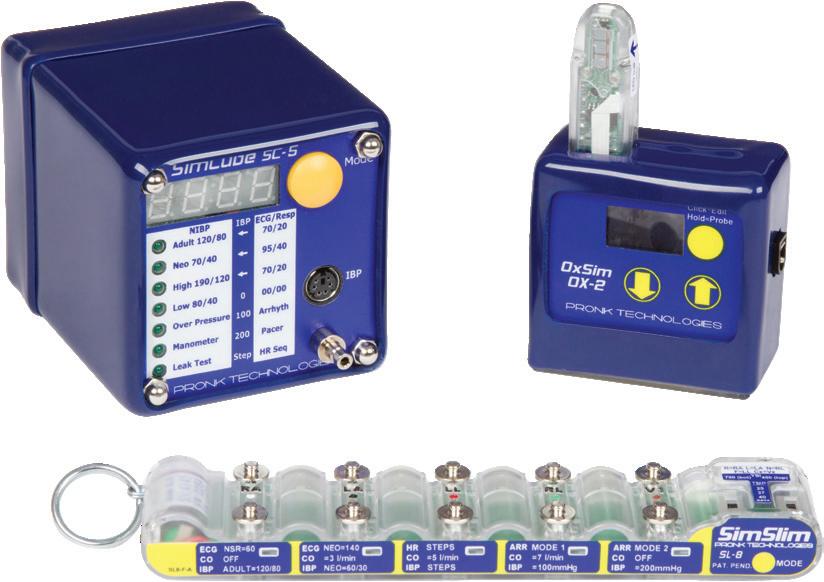

70 TechNation | April 2024
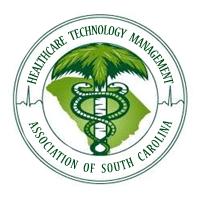

Register to attend the HTMA-SC Symposium Charleston, SC at the Marriott May 9-10, 2024 170 Lockwood Boulevard Charleston, SC 29403 htma-sc.org
•
•
•

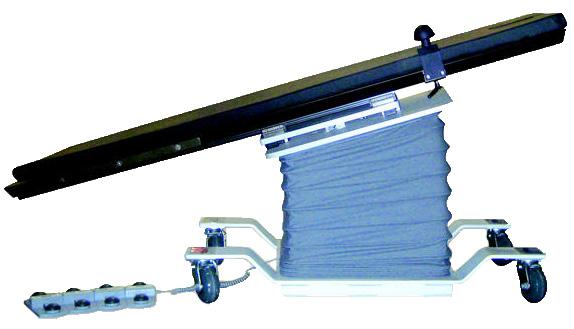

BREAKROOM WHAT’S ON Y UR BENCH? Morton Campbell Imaging Specialist I, Erlanger Health System
Starbucks Carmel Macchiato
Wiha Drive-Loc Drivers
•
•
Milwaukee Electric Screwdriver
Paint Markers
Side cutters Submit your bench to be featured in TechNation at 1technation.com/my-bench/. You could win a $25 Amazon gift card via the “What’s On Your Bench” Contest! WE BUY AND SELL PRE-OWNED MEDICAL IMAGING EQUIPMENT. ALL MANUFACTURES & MODALITIES CUSTOMERS FIRST SINCE 1987 TOSHIBA • GE • PHILIPS • SIEMENS AND MORE! Website: www.InternationalXrayBrokers.com Email: admin@intxray.com Call: 508.730.9544 or 508.559.9441 DISTRIBUTOR FOR CUSTOM BUILT SURGICAL TABLES REFURBISHED G.E. AMX PORTABLES AND OEC C-ARMS 72 TechNation | April 2024


































































What’s the most important thing to you in a work place? TECHNATI N P LL Connect with TechNation on LinkedIn at linkedin.com/company/iamtechnation to participate in our next poll: Favorite Spring Sport DEVELOPMENT OPPORTUNITIES 29% FLEXIBILITY 13% HEALTHY ENVIRONMENT 38% THE WORK I AM DOING 21% 40UNDER 40 YP AT MD Deadline To Apply APRIL 26, 2024 APPLY NOW! for the 2024 Class of 40 Under 40 MD YPat YOUNG AT MD EXPO! ( ) For more information on YP at MD, visit our site! 1TECHNATION.COM/YP/ April 2024 | TechNation 73


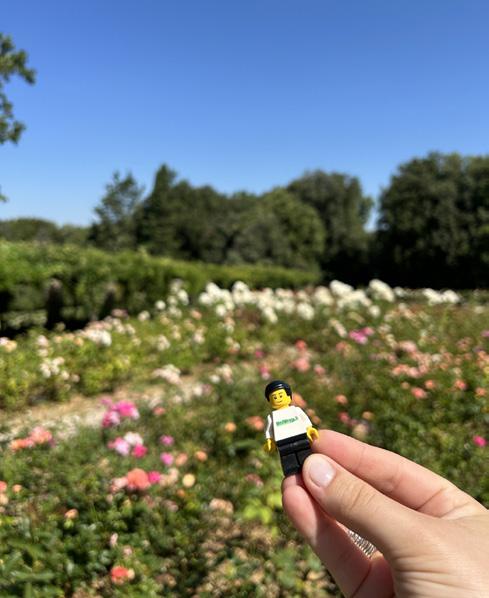

An online resource where medical equipment professionals can find all the information needed to help them be more successful! The easy to navigate Bulletin Board gives you access to informative blogs, expos and events, continuing education opportunities, and a job board. Visit MedWrench.com/BulletinBoard to find out more about this resource. Follow MedWrench on facebook.com/medwrench & linkedin.com/company/medwrench BULLETIN BOARD APRIL 22 - 26, 2024 DIGITALHOLOGICMAMMOGRAPHY: SELENIA APRIL 29 - MAY 3, 2024 CANON RADPRO DIGITAL STAY TUNED FOR OUR HTM WEEK CONTEST! UPCOMING EXPOS & EVENTS Save the date for HTMA - SC! MAY 9-10, 2024 Spring time adventures! Ready for another MD Expo! UPCOMING EDUCATION Join TechNation for a HTM Mixer in Indy! MAY 2-3, 2024 74 TechNation | April 2024

ACROSS 1 Important factor in selecting a patient monitor, 2 words 8 Stroage disc 9 Bind 10 Roman and Greek physician who was one of the great pioneer medical researchers 12 Medical testing area 14 Half 15 Company expert in the sale or repair of monitoring equipment, 2 words 19 Type of medical clamp 21 Blood poisoning 24 Limits or specific requirements for the operation of a piece of medical equipment 29 Inert gas symbol 31 Shows 32 Manning of the NY Giants 33 Earth (prefix) 34 Polite address to a customer 35 Keep securely DOWN 1 ___ blocker 2 ____ imaging: impressive and compact method of identifying, measuring and visualizing heat patterns 3 Electrocardiogram, abbr. 4 Vitamin bottle info, abbr. 5 Lithium-____ battery 6 Culled from diverse sources 7 The first M in MMA 11 Lights 13 Org. with a caduceus logo, abbr. 14 Yes in Spain 16 Important documents or cards to prevent unauthorized access 17 Drop a little 18 Statistical group 20 Retirement account, abbr. 22 Time just before an event 23 Mechanical or electronic equipment adapted for a particular purpose 25 Type of waves used in infant monitoring systems and patient telemetry 26 Protective secretion 27 Expression of the concentration of a solution 28 Increases 30 Part of binary code BIOMED BRAINBUSTER Visit 1technation.com/crossword for an interactive puzzle. BREAKROOM April 2024 | TechNation 75

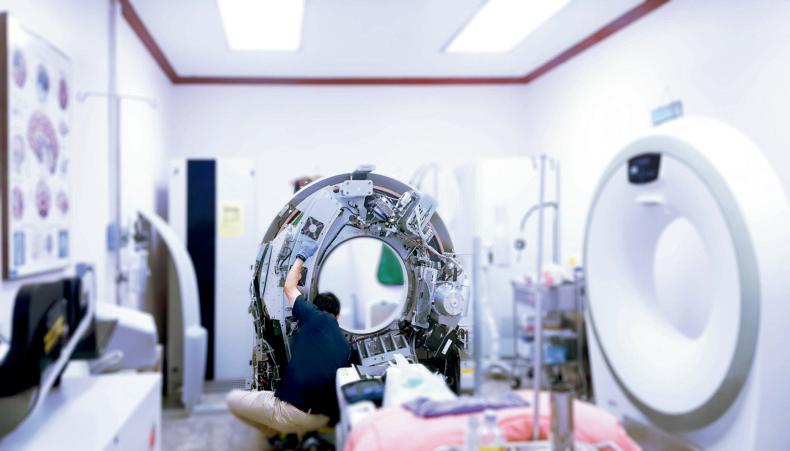























































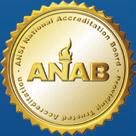


ROI REALIZATION THROUGH TEST EQUIPMENT AUTOMATION 1.877.254.7086 Sales@QRS-Solutions.com www.QRS-Solutions.com ISO 17025:2017 CALIBRATIONS CERTIFIED TO ISO 9001:2015 ANSI/NCSL Z540-1 ECAT SUPPLIER Improve Productivity! Complete PMs & Process Work Orders More Efficiently! API Completed Test Results CMMS Work Orders Assets, Procedures, DATREND’S VI S I ON-P A D TEC H NOLOG Y ™ INTEGRATES YOUR CMMS WITH YOUR MEDICAL TESTING EQUIPMENT Automated & Manual 120-240V Testing with Wireless Interface to Your CMMS. vPad-Rugged 2 Cybersecurity. Clinical Engineering. Capital Equipment Planning. Renovo1.com HTM - MADE REALLY SIMPLE. We’re on LinkedIn! FOLLOW US: linkedin.com/company/iamtechnation Join our newsletter! 1technation.com/yp/ SCAN BELOW 76 TechNation | April 2024
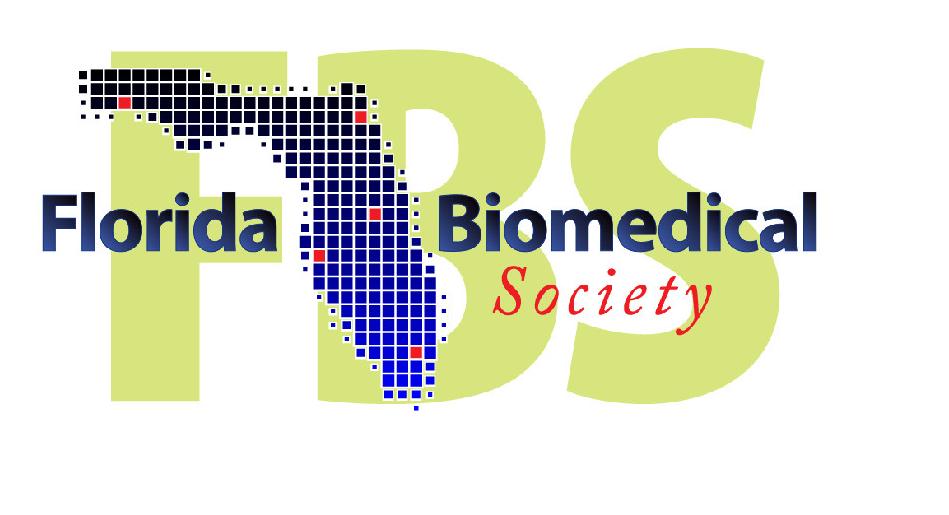
The 2024 Florida Biomedical Society Symposium was a popular destination for the state’s HTM professionals. The event offered networking events, educational opportunities and an exhibit hall with representatives from the industry’s leading companies.
For more information about FBS and upcoming events, visit fbsonline.net.
1
SCRAP BOOK
1. TechNation and MedWrench always look forward to exhibiting at the FBS symposium.
2. TechNation took the opportunity to surprise FBS with the Wrenchie for Association of the Year, sponsored by MultiMedical Systems.
3. FBS and Tyler’s Hope kicked off the annual symposium with a charity event at Topgolf Orlando.
4. TSS was one of the exhibitors showcasing the latest technology

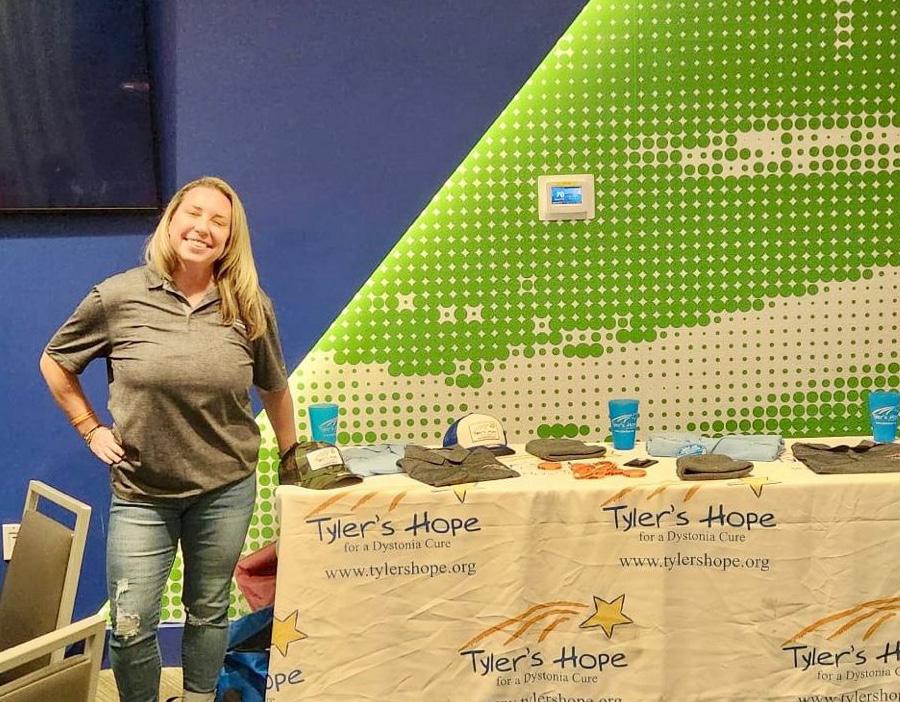

4
3 5 6

and products inside the exhibit hall.
5. Members of the TechNation Digital Advisory Board and industry influencers Carlos Villafane and Bryant Hawkins Sr. were on hand to bring the industry updates from this event.
6. Rhiannon Thurmond led a class titled “I am Woman. I am HTM,” giving a unique perspective on the increased presence and role of women in HTM.
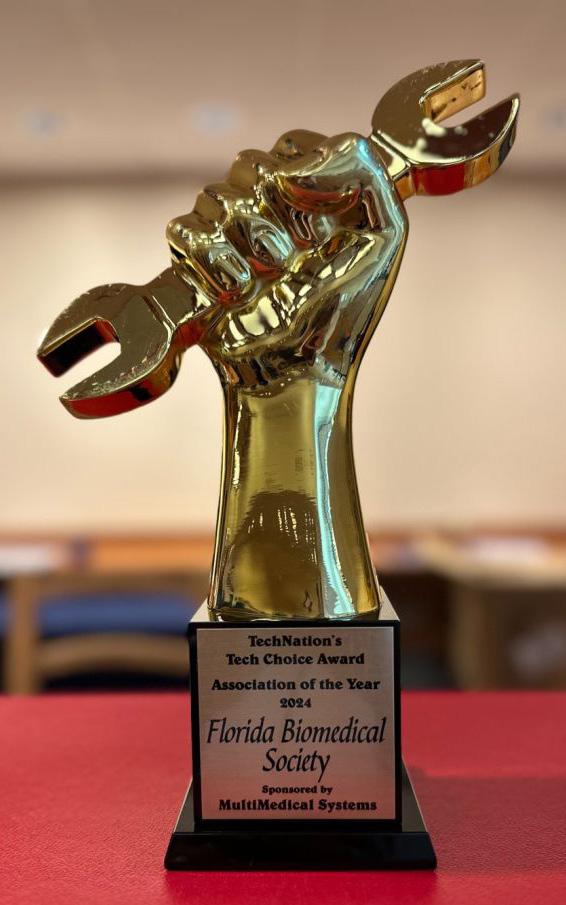
2

BREAKROOM April 2024 | TechNation 77
Company Info AD PAGE PARTS SERVICE TRAINING Company Info AD PAGE PARTS SERVICE TRAINING SERVICE INDEX Anesthesia USOC Medical usocmedical.com • 855-888-8762 3 P P Asset Management Capital i capitali.us • 417-708-2924 27 EQ2 eq2llc.com • 888-312-4367 26 Renovo Solutions renovo1.com • 844-4RENOVO 76 P P TruAsset, LLC truasset.com • 214-276-1280 63,81 Association AAMI www.aami.org • 703-525-4890 56 P Biomedical BC Group International, Inc BCGroupStore.com • 314-638-3800 84 College of Biomedical Equipment Technology cbet.edu • 866-866-9027 11 P J2S Medical www.j2smedical.com • 844-342-5527 81 P P Maull Biomedical Training maullbiomedicaltraining.com • 440-724-7511 59 P P P MultiMedical Systems multimedicalsystems.com • 888-532-8056 43 P P Probo Medical probomedical.com • 3174947872 21 Pronk Technologies, Inc. pronktech.com • 800-609-9802 2,70,81 Renovo Solutions renovo1.com • 844-4RENOVO 76 Soma Tech Intl somatechnology.com • 800-438-7662 29 C-Arm International X-Ray Brokers internationalxraybrokers.com • 508-559-9441 72 Probo Medical probomedical.com • 3174947872 21 P P Soma Tech Intl somatechnology.com • 800-438-7662 29 P P Cardiology Southeastern Biomedical, Inc sebiomedical.com/ • 828-396-6010 65 P P CMMS EQ2 eq2llc.com • 888-312-4367 26 Pronk Technologies, Inc. pronktech.com • 800-609-9802 2,70,81 TruAsset, LLC truasset.com • 214-276-1280 63,81 Computed Tomography CM Parts Plus cmpartsplus.com • 877-267-2784 30 P P Diagnostic Solutions diagnostic-solutions.com • 330-296-9729 69 P P International X-Ray Brokers internationalxraybrokers.com • 508-559-9441 72 KEI Medical Imaging Services keimedicalimaging.com • 512-477-1500 63 Maull Biomedical Training maullbiomedicaltraining.com • 440-724-7511 59 P P P RSTI rsti-training.com • 800-229-7784 7 P P P Tri-Imaging Solutions triimaging.com • 855-401-4888 70,83 P P P Consultancy NVRT Labs Inc. nvrtlabs.com • 38 Contrast Media Injectors Maull Biomedical Training maullbiomedicaltraining.com • 440-724-7511 59 P P P Cyber Security College of Biomedical Equipment Technology cbet.edu • 866-866-9027 11 P Renovo Solutions renovo1.com • 844-4RENOVO 76 Defibrillator Soma Tech Intl somatechnology.com • 800-438-7662 29 P P Diagnostic Imaging CM Parts Plus cmpartsplus.com • 877-267-2784 30 P P Diagnostic Solutions diagnostic-solutions.com • 330-296-9729 69 P P Innovatus Imaging innovatusimaging.com • 844-687-5100 8 International X-Ray Brokers internationalxraybrokers.com • 508-559-9441 72 Maull Biomedical Training maullbiomedicaltraining.com • 440-724-7511 59 P P P 78 TechNation | April 2024
Company Info AD PAGE PARTS SERVICE TRAINING Company Info AD PAGE PARTS SERVICE TRAINING Probo Medical probomedical.com • 3174947872 21 P P Renovo Solutions renovo1.com • 844-4RENOVO 76 Tri-Imaging Solutions triimaging.com • 855-401-4889 70,83 P P Education/Training College of Biomedical Equipment Technology cbet.edu • 866-866-9027 11 P ECRI Institute ecri.org • 610-825-6000 16 P Maull Biomedical Training maullbiomedicaltraining.com • 440-724-7511 59 P NVRT Labs Inc. nvrtlabs.com • 38 RSTI rsti-training.com • 800-229-7784 7 P Tri-Imaging Solutions triimaging.com • 855-401-4892 70,83 Webinar Wednesday http://webinarwednesday.live/ • 55 P Employment/Recruiting HTM Jobs www.htmjobs.com • 48 Multimedical Systems multimedicalsystems.com • 888-532-8056 43 Endoscopy Healthmark Industries hmark.com • 800-521-6224 17 P P Multimedical Systems multimedicalsystems.com • 888-532-8056 43 P P General ALCO Sales & Service Co. www.alcosales.com • 800-323-4282 67 EQ2 eq2llc.com • 888-312-4367 26 SalesMaker Carts salesmakercarts.com • 800-821-4140 22 Infection Control Healthmark Industries hmark.com • 800-521-6224 17 P P Infusion Pumps AIV aiv-inc.com • 888-587-6759 4 P P BC Group International, Inc BCGroupStore.com • 314-638-3800 84 Elite Biomedical Solutions elitebiomedicalsolutions.com • 855-291-6701 35 P P J2S Medical www.j2smedical.com • 844-342-5527 81 P P J2S Medical www.j2smedical.com • 844-342-5527 81 P P Multimedical Systems multimedicalsystems.com • 888-532-8056 43 P P PM Biomedical pmbiomedical.com • 800-777-6474 73 P P Pronk Technologies, Inc. pronktech.com • 800-609-9802 2,70,81 USOC Medical usocmedical.com • 855-888-8762 3 P P Installs/Deinstalls KEI Medical Imaging Services keimedicalimaging.com • 512-477-1500 63 Laboratory College of Biomedical Equipment Technology cbet.edu • 866-866-9027 11 P Labratory Ozark Biomedical ozarkbiomedical.com • 800-457-7576 38 P P Mammography RSTI rsti-training.com • 800-229-7784 7 P P P Monitors/CRTs Soma Tech Intl somatechnology.com • 800-438-7662 29 P P Tenacore LLC tenacore.com • 800-297-2241 6 P P MRI CM Parts Plus cmpartsplus.com • 877-267-2784 30 P P Diagnostic Solutions diagnostic-solutions.com • 330-296-9729 69 P P Innovatus Imaging innovatusimaging.com • 844-687-5100 8 International X-Ray Brokers internationalxraybrokers.com • 508-559-9441 72 KEI Medical Imaging Services keimedicalimaging.com • 512-477-1500 63 Probo Medical probomedical.com • 3174947872 21 P P Tri-Imaging Solutions triimaging.com • 855-401-4891 70,83 P P Nuclear Medicine Diagnostic Solutions diagnostic-solutions.com • 330-296-9729 69 P P International X-Ray Brokers internationalxraybrokers.com • 508-559-9441 72 Online Resource MedWrench www.MedWrench.com • 31 Oxygen Blender Tenacore LLC tenacore.com • 800-297-2241 6 P P Patient Monitors AIV aiv-inc.com • 888-587-6759 4 P P April 2024 | TechNation 79
Company Info AD PAGE PARTS SERVICE TRAINING Company Info AD PAGE PARTS SERVICE TRAINING SERVICE INDEX CONTINUED BC Group International, Inc BCGroupStore.com • 314-638-3800 84 Elite Biomedical Solutions elitebiomedicalsolutions.com • 855-291-6701 35 P P PM Biomedical pmbiomedical.com • 800-777-6474 73 P P Pronk Technologies, Inc. pronktech.com • 800-609-9802 2,70,81 Southeastern Biomedical, Inc sebiomedical.com/ • 828-396-6010 65 P P Tenacore LLC tenacore.com • 800-297-2241 6 P P USOC Medical usocmedical.com • 855-888-8762 3 P P Refurbish Innovatus Imaging innovatusimaging.com • 844-687-5100 8 Rental/Leasing J2S Medical www.j2smedical.com • 844-342-5527 81 Repair AIV aiv-inc.com • 888-587-6759 4 P P BC Group International, Inc BCGroupStore.com • 314-638-3800 84 CM Parts Plus cmpartsplus.com • 877-267-2784 30 P P Elite Biomedical Solutions elitebiomedicalsolutions.com • 855-291-6701 35 Innovatus Imaging innovatusimaging.com • 844-687-5100 8 International X-Ray Brokers internationalxraybrokers.com • 508-559-9441 72 PM Biomedical pmbiomedical.com • 800-777-6474 73 P P Soma Tech Intl somatechnology.com • 800-438-7662 29 Tenacore LLC tenacore.com • 800-297-2241 6 Replacement Parts AIV aiv-inc.com • 888-587-6759 4 P P Diagnostic Solutions diagnostic-solutions.com • 330-296-9729 69 P P Elite Biomedical Solutions elitebiomedicalsolutions.com • 855-291-6701 35 J2S Medical www.j2smedical.com • 844-342-5527 81 KEI Medical Imaging Services keimedicalimaging.com • 512-477-1500 63 PM Biomedical pmbiomedical.com • 800-777-6474 73 P P Tenacore LLC tenacore.com • 800-297-2241 6 USOC Medical usocmedical.com • 855-888-8762 3 Software EQ2 eq2llc.com • 888-312-4367 26 TruAsset, LLC truasset.com • 214-276-1280 63,81 Surgical MultiMedical Systems multimedicalsystems.com • 888-532-8056 43 P Telemetry AIV aiv-inc.com • 888-587-6759 4 P P Elite Biomedical Solutions elitebiomedicalsolutions.com • 855-291-6701 35 P P PM Biomedical pmbiomedical.com • 800-777-6474 73 P P USOC Medical usocmedical.com • 855-888-8762 3 P P Test Equipment BC Group International, Inc BCGroupStore.com • 314-638-3800 84 P P Healthmark Industries hmark.com • 800-521-6224 17 P P Pronk Technologies, Inc. pronktech.com • 800-609-9802 2,70,81 P P QRS Solutions qrs-solutions.com/ • 877-254-7086 76 P P Southeastern Biomedical, Inc sebiomedical.com/ • 828-396-6010 65 P P Ultrasound Innovatus Imaging innovatusimaging.com • 844-687-5100 8 MW Imaging www.mwimaging.com • 877-889-8223 22 P P P Probo Medical probomedical.com • 3174947872 21 P P Summit Imaging Inc mysummitimaging.com • 866-586-3744 24 P P P X-Ray RSTI rsti-training.com • 800-229-7784 7 P P P Tri-Imaging Solutions triimaging.com • 855-401-4890 70,83 P P 80 TechNation | April 2024









ALPHABETICAL INDEX AAMI 56 AIV 4 ALCO Sales & Service Co. 67 BC Group International, Inc 84 Capital i 27 CM Parts Plus 30 College of Biomedical Equipment Technology 11 Diagnostic Solutions 69 ECRI Institute 16 Elite Biomedical Solutions ………… 35 EQ2 26 Healthmark Industries 17 HTM Jobs 48 Innovatus Imaging 8 International X-Ray Brokers 72 J2S Medical 81 KEI Medical Imaging Services 63 Maull Biomedical Training 59 MedWrench 31 Multimedical Systems 43 MW Imaging 22 NVRT Labs Inc. 38 Ozark Biomedical 38 PM Biomedical 73 Probo Medical 21 Pronk Technologies, Inc. 2,70,81 QRS Solutions 76 Renovo Solutions 76 RSTI 7 SalesMaker Carts 22 Soma Tech Intl 29 Southeastern Biomedical, Inc 65 Summit Imaging Inc 24 Tenacore LLC 6 Tri-Imaging Solutions 70,83 TruAsset, LLC 63,81 USOC Medical 3 Webinar Wednesday 55 Operate Efficiently, Perform Real Time, Simplify Compliance Simplify the PM Process www.truasset.com 214-276-1280 sales@truasset.com Wireless automation has arrived! Automated Electrical Safety, Simulation & IV Pump Test Sequences P Complete control + data capture P Run user-defined / manufacturers’ checklists P Generates a complete electronic test report April 2024 | TechNation 81
SHOW US YOUR SH P
The Show Us Your Shop feature is where TechNation will share submitted photos of your biomed/HTM shops. Clean? Messy? We want to see them ALL!
Simply post your photo on social media and use the hashtag #ShowUsYourShop. A member of the TechNation team will contact you for approval.

I was busy today with corrective service and preventive maintenance!


Beware: Dr. Jeffrey Smoot is checking up on us...
First year students getting to watch and participate in our ESU and defibrillator labs.
Photo by Nicole Ruffin
Photo by Matt Haley
BREAKROOM
Photo by Isaiah Ledesma
82 TechNation | April 2024


SOLUTIONS We have the key to your success. ISO 13485:2016 certified Become an Imaging Engineer. Start an exciting career as a Medical Imaging Service Engineer with the Apprentice Program at Tri-Imaging! We have a world-class hands on training facility at our facility in Madison, TN. 2 WEEKS BMET to Imaging 1 training 2 WEEKS BMET to Imaging 2 training 8 WEEKS Technical Services 12 WEEK APPRENTICE PROGRAM Visit triimaging.com/training/training-program.html to see our Training Calendar! 855.401.4888 Located in Nashville, TN























































































































































































































































































































































